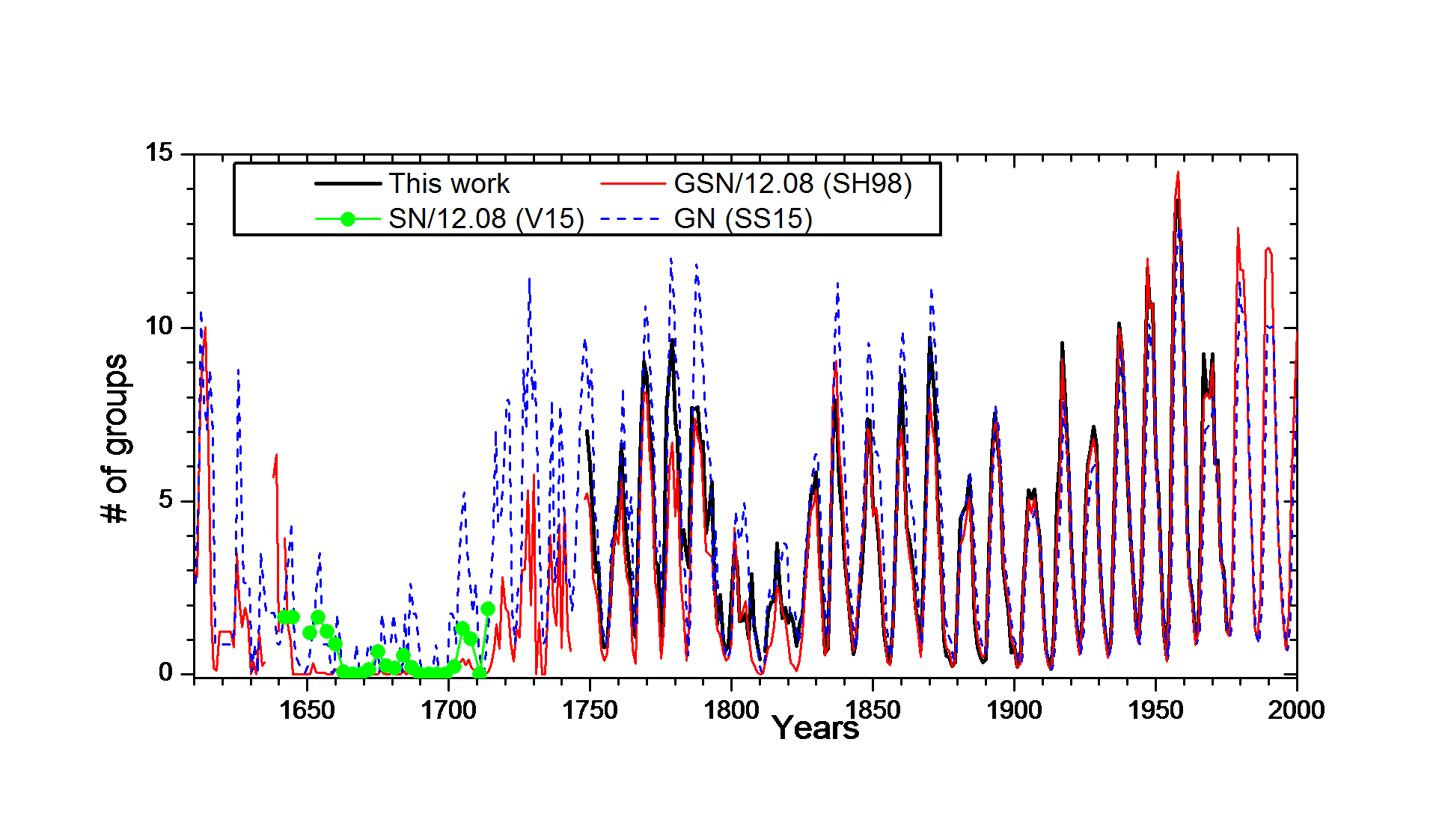List of all science nuggets
- 6 Feb 202027 Jan 202012 Oct 20191 Aug 201924 Jun 201912 Apr 201919 Jan 201910 Dec 20185 Dec 20181 Dec 20188 Nov 201824 Sep 201821 May 201815 May 201822 Nov 20172 Nov 20172 June 20172 June 20172 June 20171 June 20171 June 201717 Feb 201718 Jan 201718 Jan 201718 Jan 201727 Jun 2016
- 27 Jun 2016
- 13 Apr 201613 Apr 201613 Apr 201613 Apr 201612 Nov 201511 Nov 201511 Nov 201514 Aug 2015
Science Nuggets
Here you can find short mini-articles, 'science nuggets', about recent discoveries made by ReSoLVE.
- Strong modulation of precipitating energetic electrons by the dawn-dusk component of interplanetary magnetic field
6 February 2020
-
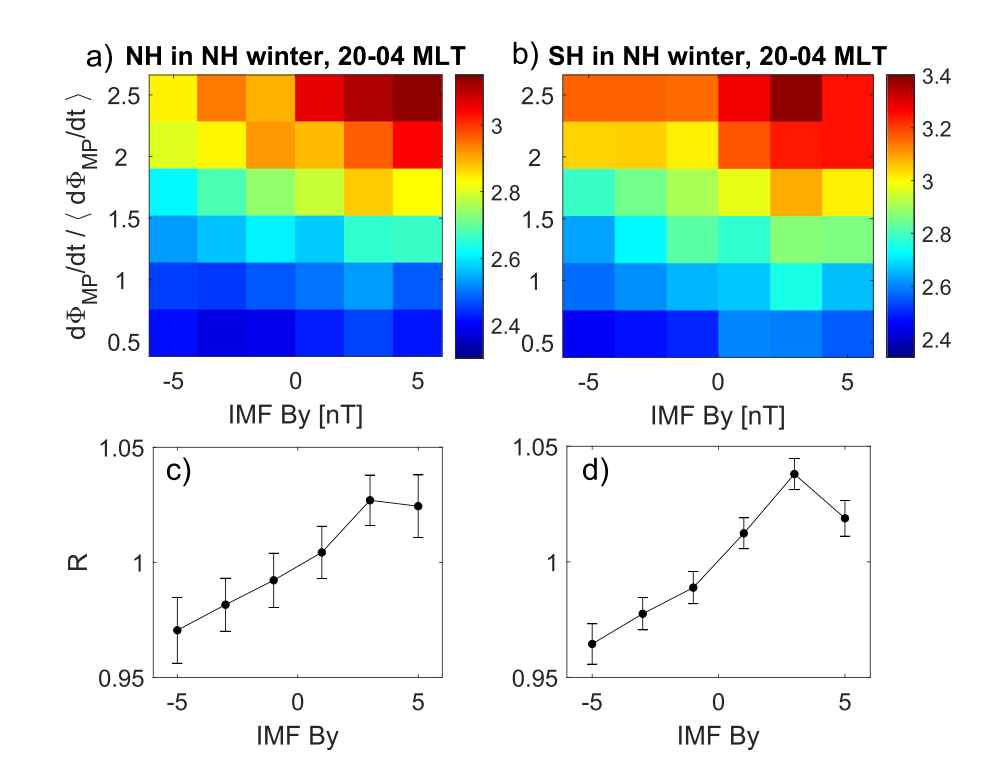
Recent studies have shown the dawn-dusk (By) component of the interplanetary magnetic field strongly modulate the response of geomagnetic activity to solar wind variations. In our recent study [Holappa et al., 2018] we found evidence that this By-effect works more efficiently in the winter hemisphere than in the summer hemisphere. In this paper, we use measurements of NOAA Polar-Orbiting Operational Environmental Satellites to show that the flux of magnetospheric electrons precipitating into the atmosphere also exhibits an explicit By-dependence. This By-dependence is strong in the midnight and dawn sectors where it causes a related By-effect in the westward electrojet and geomagnetic activity by modulating ionospheric conductivity. This effect in conductivity is relatively more important in the winter hemisphere, thus explaining the winter maximum in the By-effect.
-
Reference:
- Abrupt shrinking of solar corona in the late 1990s
27 January 2020
-
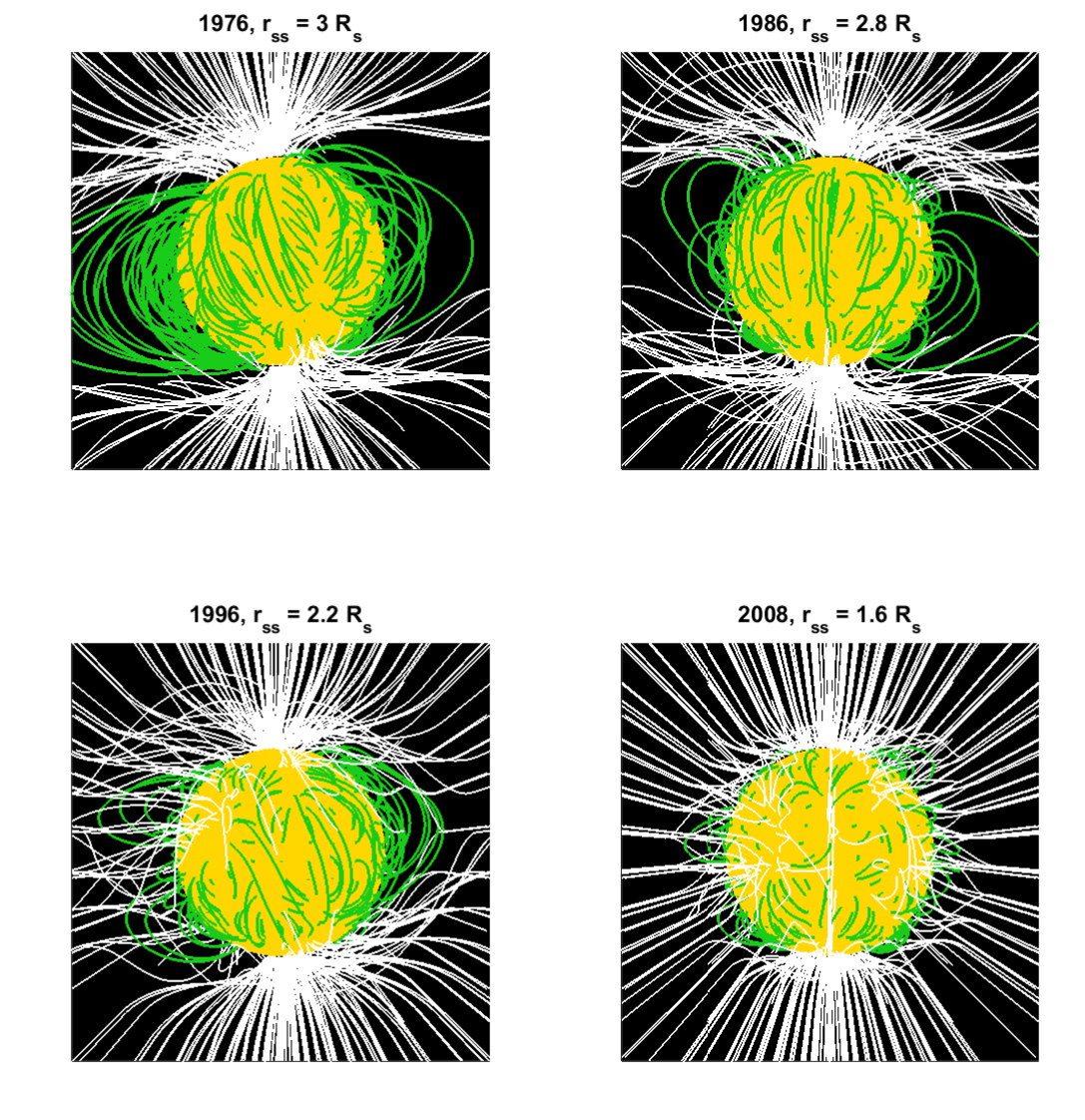
In this study we derive the longest uniform record of rotational intensities solar coronal magnetic field since 1968 and compare it with the heliospheric magnetic field observed at the Earth. We scale the Mount Wilson Observatory (MWO) and Wilcox Solar Observatory (WSO) observations of the photospheric magnetic field to the level of the SOLIS/VSM magnetograph and apply the PFSS model to calculate the coronal magnetic field. Results show that the evolution of the coronal magnetic field during the last 50 years agrees with the heliospheric magnetic field observed at the Earth only if the effective coronal size, the distance of the coronal source surface of the heliospheric magnetic field is allowed to change in time. We calculate the optimum source surface distance for each rotation and find that it experienced an abrupt decrease in the late 1990s. The effective volume of the solar corona shrunk to less than one half during a short period of only a few years. This abrupt shrinking coincides with other changes in solar magnetic fields that are likely related to the decrease of the overall solar activity, i.e., the demise of the Grand Modern Maximum.
-
Reference:
- Influence of energetic electron precipitation on polar vortex is amplified by to planetary wave activity
12 Oct 2019
-
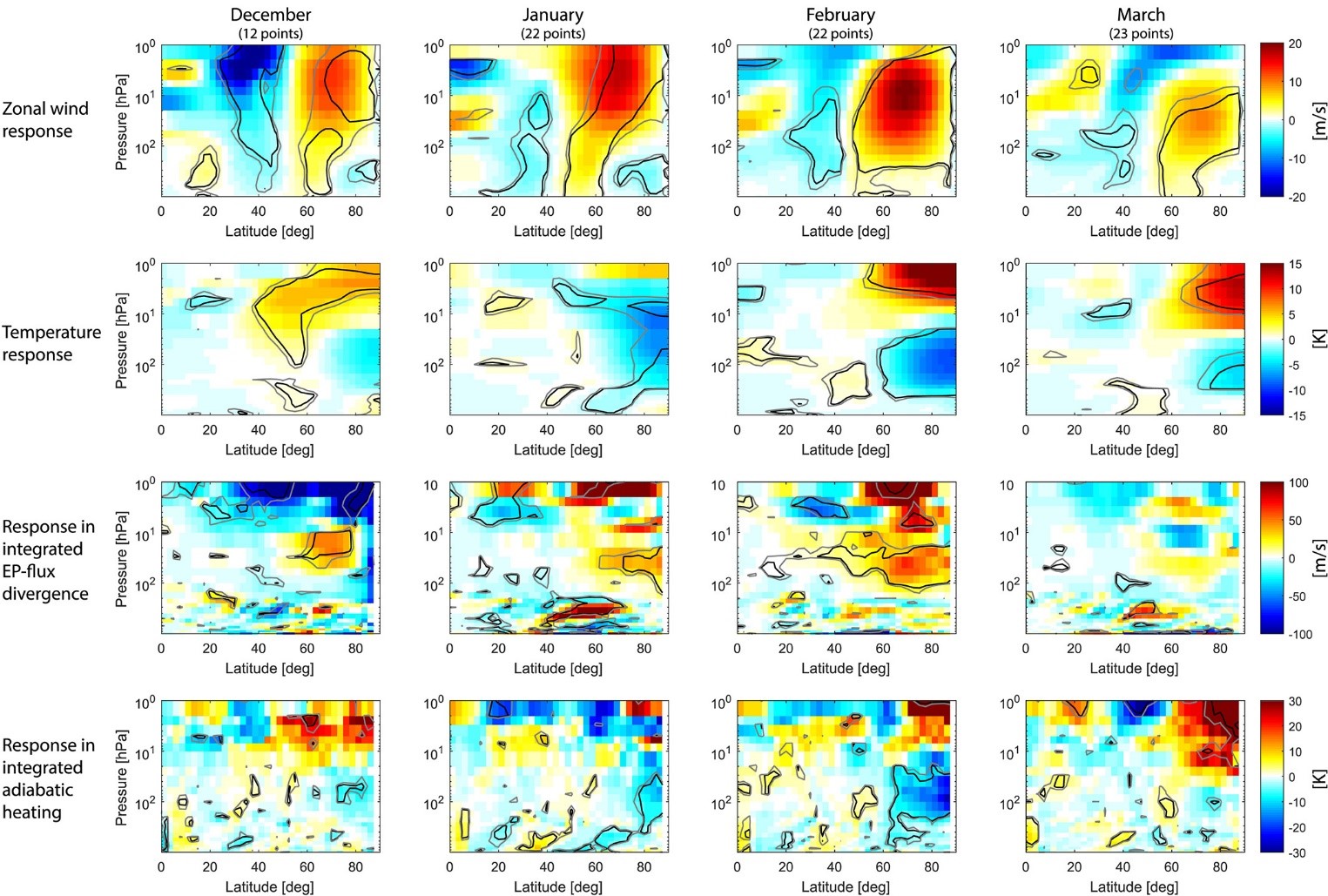
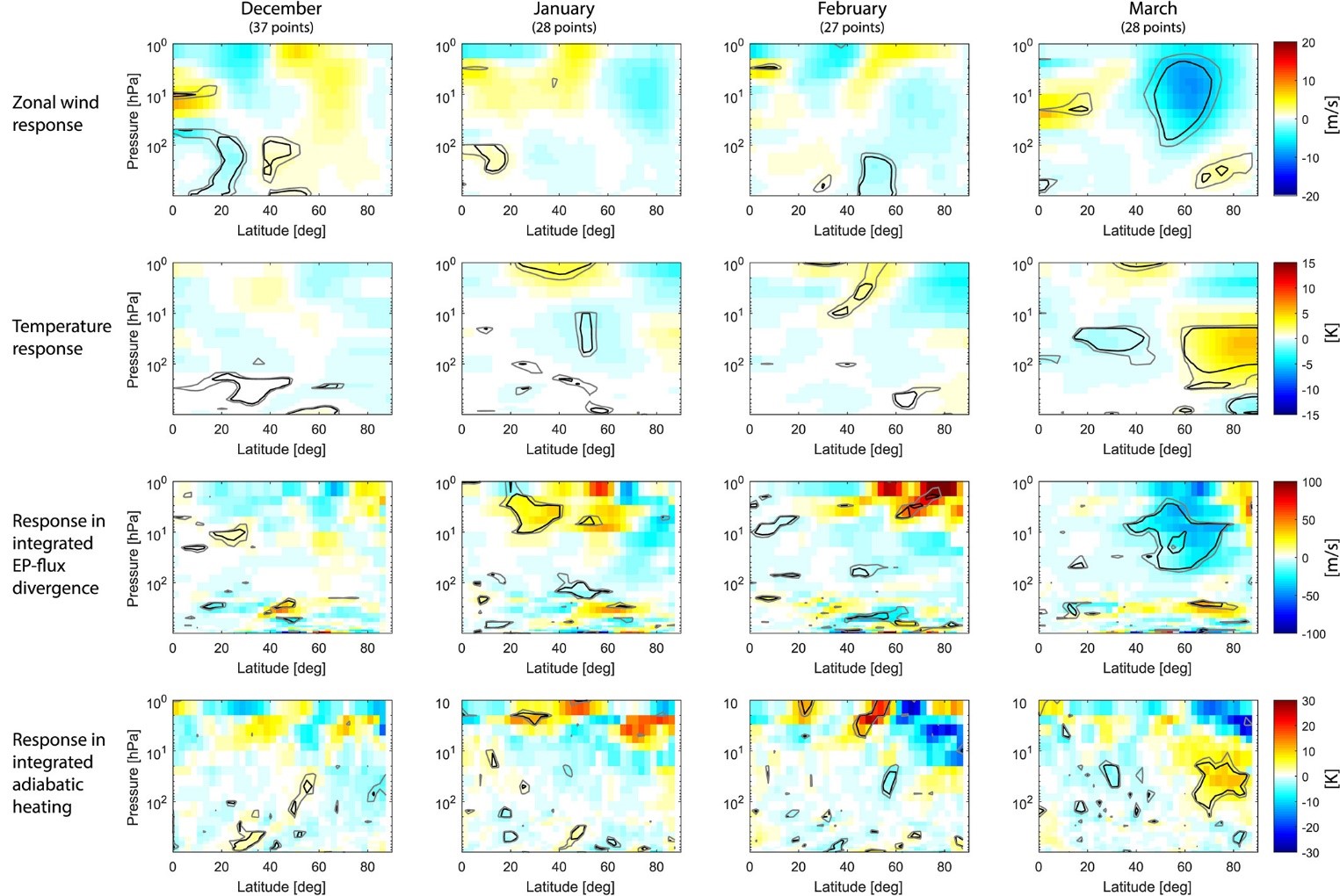
The wintertime weather on the Northern Hemisphere is greatly influenced by variation of the polar vortex, which is a strong westerly wind that forms in the polar stratosphere each winter. Recent research has established a link between polar vortex variations and energetic electron precipitation from the near‐Earth space into the polar atmosphere, which is mediated by electron precipitation‐induced chemical changes causing ozone loss in the mesosphere and stratosphere. The most dramatic changes in the polar vortex are due to sudden stratospheric warmings, where the vortex temporarily breaks. Here we study how these warming events influence the effect of electron precipitation on the polar vortex. We find that the electron precipitation enhances the polar vortex but preferentially during times preceding the sudden stratospheric warmings. We show that during these times, the initial response to electron precipitation is efficiently amplified by the same planetary wave activity, which later breaks the polar vortex. These results highlight the importance of considering sufficiently strong planetary wave activity typically associated to sudden stratospheric warmings as a necessary condition for observing the effects of electron precipitation on the polar vortex dynamics.
- Energetic electron precipitation greatly influences the occurrence of Sudden Stratospheric Warmings
1 August 2019
-
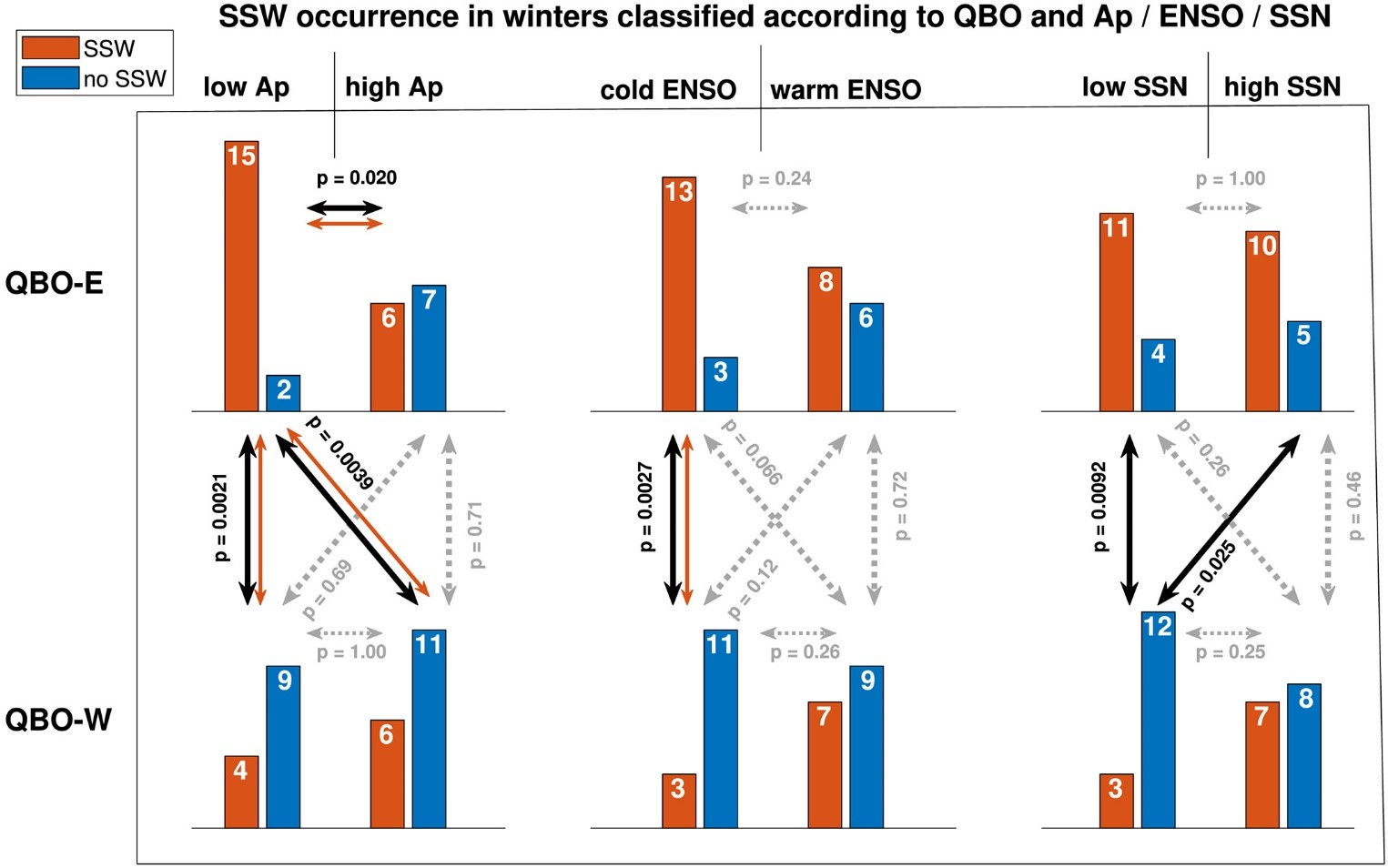
A sudden stratospheric warming (SSW) is a large‐scale disturbance of the wintertime stratosphere, which occurs especially in the Northern Hemisphere. Earlier studies have shown that SSW occurrence depends on atmospheric internal factors and on solar activity. We examined the SSW occurrence in northern winters from 1957-2017 and considered several factors that may affect the SSW occurrence: Quasi‐Biennial Oscillation (QBO), El Niño–Southern Oscillation (ENSO), geomagnetic activity (which was used as a proxy for energetic electron precipitation), and solar radiation. Our findings confirmed the well‐known result that SSWs occur more often in easterly QBO phase than in westerly phase. However, we showed that this difference depends on how the QBO phase is determined. We find that the difference in SSW occurrence between easterly and westerly QBO winters strengthens (weakens) if geomagnetic activity or solar activity is low (high), or if the ENSO is in a cold (warm) phase. Especially interesting finding was that when QBO phase is easterly low geomagnetic activity (i.e., low electron precipitation) produces significantly more SSWs than during high geomagnetic activity. These results are likely to have significant impact on long-term predictions of winter weather.
- New homogeneous record of energetic electrons spanning four solar cycles
24 June 2019
-
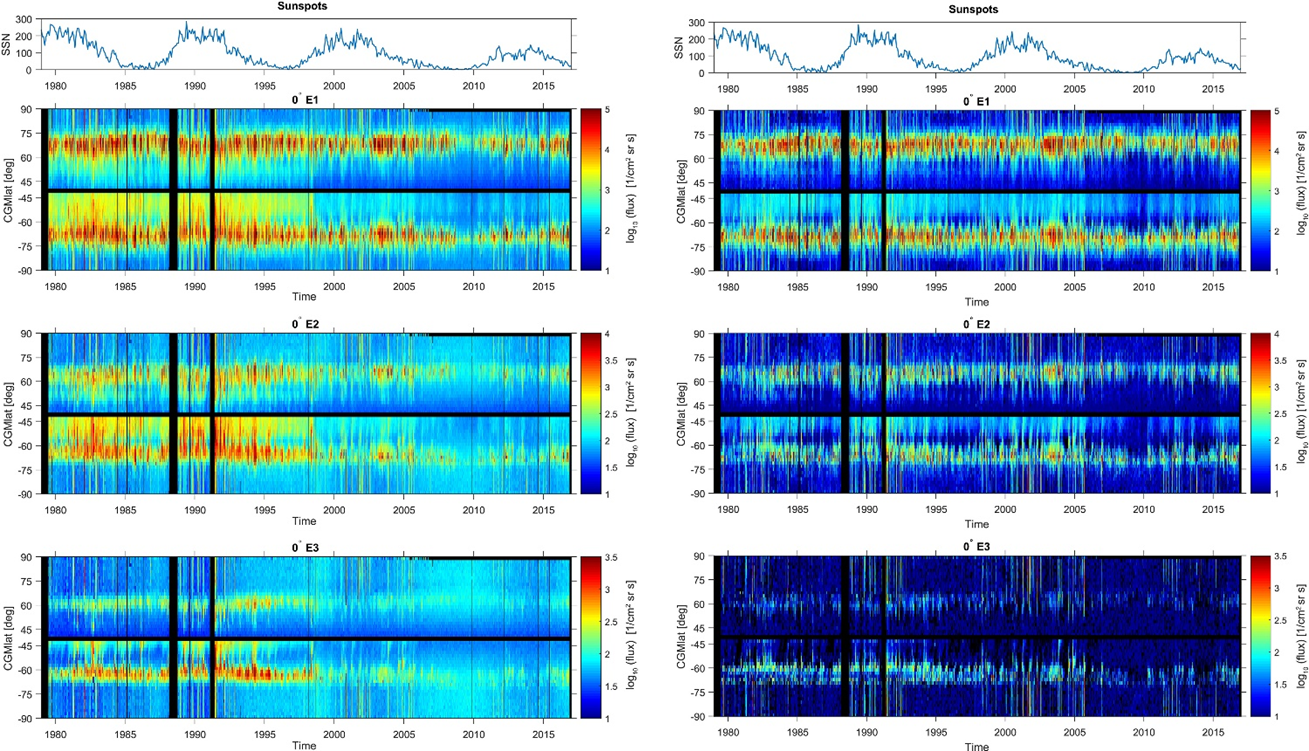
One of the most popular long‐term data sets of energetic particles used in, for example, long‐term radiation belt studies and in atmospheric/climate studies is perhaps the NOAA/POES (Polar Orbiting Environmental Satellites) data set, which extends nearly continuously from 1979 to present. We have now constructed a new homogeneous long‐term composite record of daily latitude distributions of energetic electrons based on the MEPED (Medium Energy Proton and Electron Detector) data. It was shown that the MEPED instruments suffer from temporally changing background, which is caused by cosmic rays impacting the instrument. Another concern for a homogeneous record of particle measurements is the slowly changing orientation of satellite orbital planes, which shift the measurement location of the satellites. If not taken into account these changes could be erroneously mistaken to be temporal changes of the particle environment, when in fact they are spatial. The largest concern for homogeneity of the POES record is the change of instruments from SEM-1 to SEM-2 in 1998 with the launch of NOAA-15. The particle telescopes in SEM-2 are oriented differently than in SEM-1 and because to this they measure different parts of the particle distributions. It was shown that these problems greatly influence the perceived temporal evolution of the energetic electrons over the last four solar cycles, and their correction is mandatory for obtaining the correct view of the past evolution. Fortunately we were able to robustly correct all these three problems and produced the longest spatially and temporally homogenized record of energetic electrons observed at low-altitude orbit. This dataset opens new possibilities, e.g., for studying the climate impacts of energetic particle precipitation.
-
Reference:
Asikainen T. and M. Ruopsa, New homogeneous composite of energetic electron fluxes from POES satellites: 1. Correction for background noise and orbital drift, J. Geophys. Res. Space Phys., 124, 1203– 1221, 2019
Asikainen, T., New homogeneous composite of energetic electron fluxes from POES satellites: 2. Inter-calibration of SEM-1 and SEM-2 instruments for the telescope viewing direction, J. Geophys. Res. Space Phys., 124, 5761– 5782, 2019
- Dawn-dusk component of the interplanetary magnetic field strongly affects space weather
12 April 2019
-
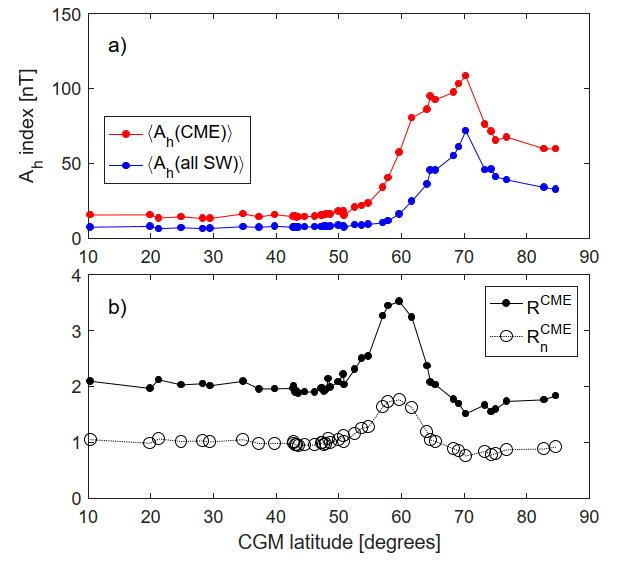
The most important parameter in the coupling between solar wind and geomagnetic activity is the north-south (Bz) component of the interplanetary magnetic field (IMF). However, recent studies have shown that the dawn-dusk (By) component of IMF is an additional, independent driver of geomagnetic activity. We use here local geomagnetic indices from a large network of magnetic stations to study how IMF By affects geomagnetic activity at different latitudes for all solar wind and, separately, during coronal mass ejections. We show that geomagnetic activity, for all solar wind, is 20% stronger for By > 0 than for By < 0 IMF at subauroral latitudes of about 60° geomagnetic latitude. During coronal mass ejections (CMEs) the By ‐effect is larger, about 40%, at slightly lower latitudes of about 57° geomagnetic latitude. These results highlight the importance of the IMF By ‐component for space weather at different latitudes and must be taken into account in space weather modeling.
-
Reference:
- Heliospheric turbulence changes on long-term scale between high and low solar cycles
19 January 2019
-
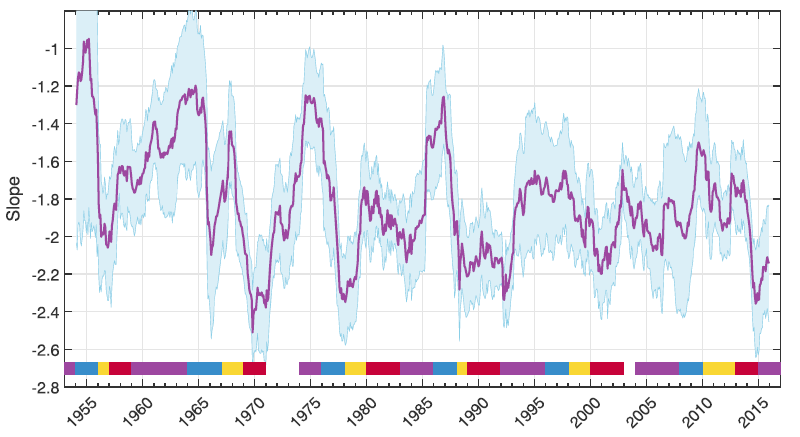
The Sun modulates the flux of galactic cosmic rays (GCR) reaching the Earth's orbit. GCR flux has been measured by ground-based neutron monitors (NMs) for several decades, which provides an interesting long-term monitor of solar activity and the heliospheric magnetic field. The referred study of the long-term evolution of the power spectrum of GCR was performed over the last six solar cycles, using the power law slope in the frequency range 5.56·10−6 to 2.14·10−6 Hz (corresponding to timescales between 50 and 130 hr). Using the data from 31 neutron monitors during 1953–2016, it was shown that the power law slopes vary within the solar cycle, with a Kolmogorov-type slope observed at solar minimum and a random-walk-type slope observed at solar maximum. This implies that the different conditions in the different phases of the solar cycle affect the scaling properties of heliospheric turbulence and, thereby, cosmic ray variability.
-
Reference:
- High-Frequency Geomagnetic Fluctuations at Auroral Oval and Polar Cap
10 December 2018
-

Rapid magnetic fluctuations are known to be closely linked to the high-latitude geomagnetic activity, in particular, to geomagnetic pulsations and subtorms. Increasing amount of commercial activity in the arctic regions requires better monitoring capability and improved understanding on the effects of geomagnetic hazards to infrastructure. In this study, we analyze rapid, 1-s fluctuations in Greenland. To measure high-frequency geomagnetic fluctuations in the auroral oval and polar cap, we use high time resolution data of 1 s from 12 stations covering a large latitudinal range. We found out that the large magnetic field fluctuations exceeding 0.2 nT/s are observed 10–30% of the time in auroral oval latitudes, depending on the solar cycle phase and station location. The latitudinal differences are much larger in fluctuation coverage (fractional derivative rate, FDR) than in fluctuations amplitude (dH/dt). The highest |dH/dt| and FDRs at noon are observed at the northern stations at Polar Cap, while in south Greenland, the highest |dH∕dt| and FDRs are recorded at midnight. The largest differences in seasonal variation between noon and midnight are observed at the polar cap, where a summer increase is seen at noon and almost flat seasonal profile at midnight.
-
Reference:
- Seasonal Variation of High-Latitude Geomagnetic Activity in Individual Years
5 December 2018
-
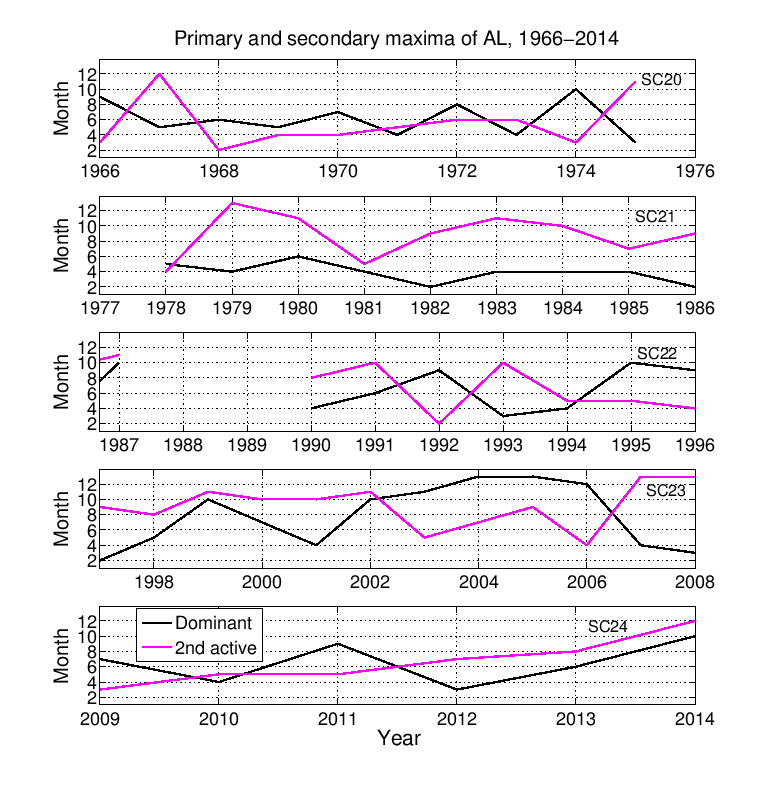
We study the seasonal variation of high-latitude geomagnetic activity in individual years in 1966 – 2014 (solar cycles 20 – 24) by identifying the most active and the second most active season based on westward electrojet indices AL (1966 - 2014) and IL (1995 - 2014). The annual maximum is found at either equinox in 2/3 and at either solstice in 1/3 of the years examined. The traditional two-equinox maximum pattern is found in roughly one fourth of the years. We found that the seasonal variation of high-latitude geomagnetic activity closely follows the solar wind speed. While the mechanisms leading to the two-equinox maxima pattern are in operation, the long-term change of solar wind speed tends to mask the effect of these mechanisms for individual years. Large cycle-to-cycle variation is found in the seasonal pattern: equinox maxima are more common during cycles 21 and 22 than in cycles 23 or 24. Exceptionally long winter dominance in high-latitude activity and solar wind speed is seen in the declining phase of cycle 23, after the appearance of the long-lasting low-latitude coronal hole.
-
Reference:
- Solar cycle occurrence of Alfvénic fluctuations and related geo-efficiency
1 December 2018
-
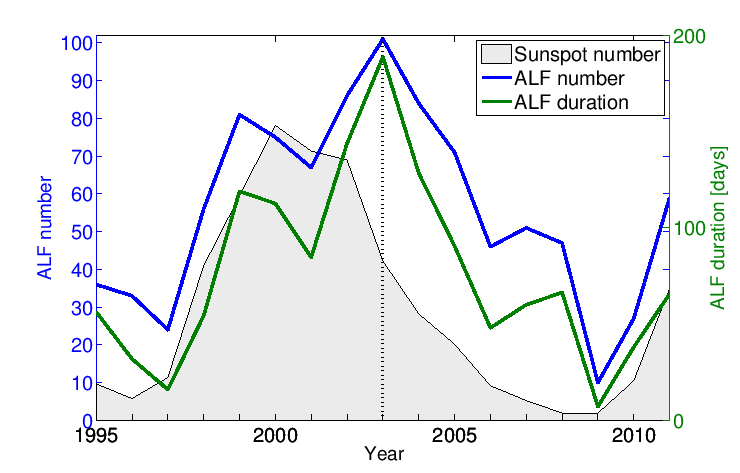
Solar wind intervals with Alfvénic fluctuations (ALFs) have been studied for 1995 - 2011. The annual number, the total annual duration and the average length of ALFs vary over the solar cycle, having a maximum in 2003 and a minimum in 2009. ALFs are most frequent in the declining phase of solar cycle, when the number of high-speed streams at the Earth´s vicinity is increased. There is a rapid transition after the maximum of solar cycle 23 from ALFs being mainly embedded in slow solar wind (< 400 km/s) until 2002 to ALFs being dominantly in fast solar wind (> 600 km/s) since 2003. Cross helicity increased by 30% from 2002 to 2003, and maximized typically 4-6 hours before solar wind speed maximum. Cross helicity remained elevated for several days for highly Alfvénic non-ICME streams, but only for a few hours for ICMEs. The number of substorms increased by about 40% from 2002 to 2003, and the annual number of substorms closely follows the annual cross helicity. This further emphasizes the role of Alfvénic fluctuations in modulating substorm activity. The predictability of substorm frequency and size would be greatly improved by monitoring solar wind Alfvénic fluctuations in addition to the mean values of the important solar wind parameters.
-
Reference:
- The Sun shows signatures of turbulent dynamo action
8 November 2018
-
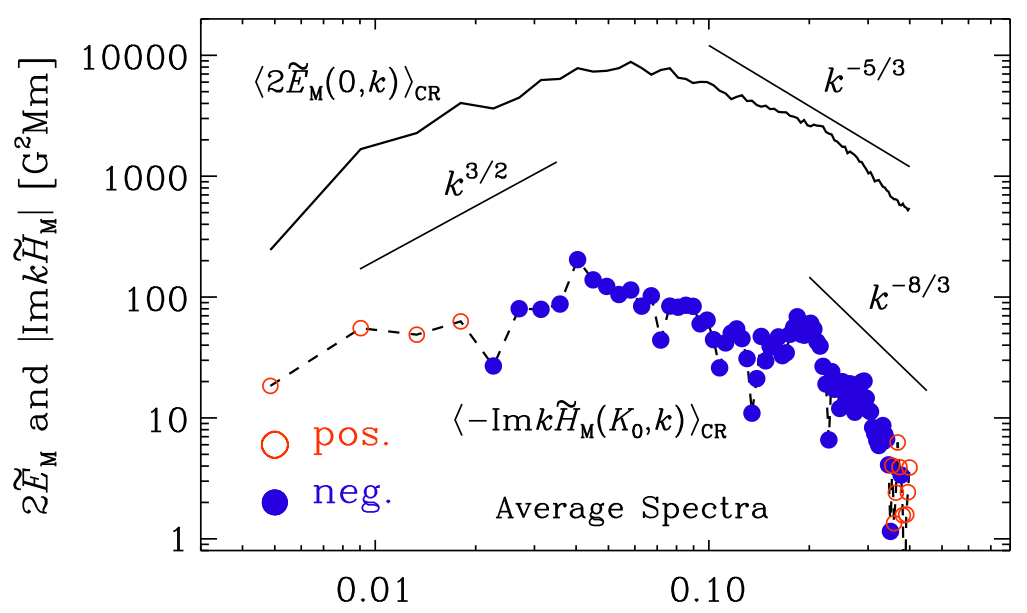
We have determined magnetic helicity spectrum from the solar surface observations using the recently developed two-scale formalism. We analyzed synoptic vector magnetograms built with data from the Vector Spectromagnetograph (VSM) instrument on the Synoptic Optical Long-term Investigations of the Sun (SOLIS) telescope during January 2010–July 2016, hence covering a large fraction of the solar cycle 24. Our study includes the total of 74 synoptic Carrington rotation maps. We recover here bihelical spectra at different phases of solar cycle 24, where the net magnetic helicity in the majority of the data is consistent with a large-scale dynamo with helical turbulence operating in the Sun. More than 20 precent of the analyzed maps, however, show violations of the expected sign rule.
-
Reference:
- Effective energy of energy-integrating cosmic ray detector
24 September 2018
-
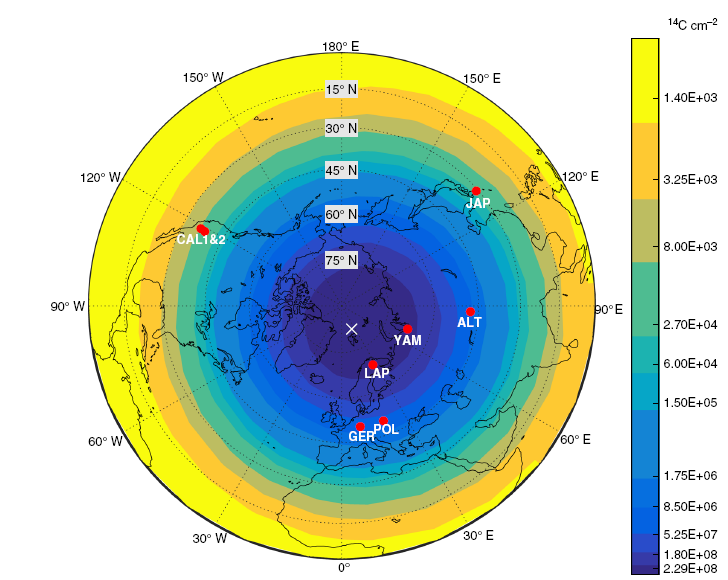
Recently, a rapid increase in radiocarbon (14C) was observed in Japanese tree rings at AD 774/775 and later confirmed in other sample from around the world. It was shown by our group that it was a severe solar energetic particle event, serving as the current paradigm of the worst-case scenario for a solar particle storm, which would, should it happen now, destroy our satellite fleet and kill astronauts in Space. However, many details yet remained incomplete. In particular, a key issue of latitudinal dependence of the 14C intensity has not been addressed. In this paper it is shown that the event was indeed caused by the Sun and occurred during the spring of AD 774. Particularly, the event intensities from various locations show a strong correlation with the latitude, demonstrating a particle-induced 14C poleward increase, in accord with the solar origin of the event. Furthermore, both annual 14C data and carbon cycle modelling, and separate earlywood and latewood 14C measurements, confine the photosynthetic carbon fixation to around the midsummer.
-
Reference:
- Explicit IMF By-dependence in geomagnetic activity
21 May 2018
-
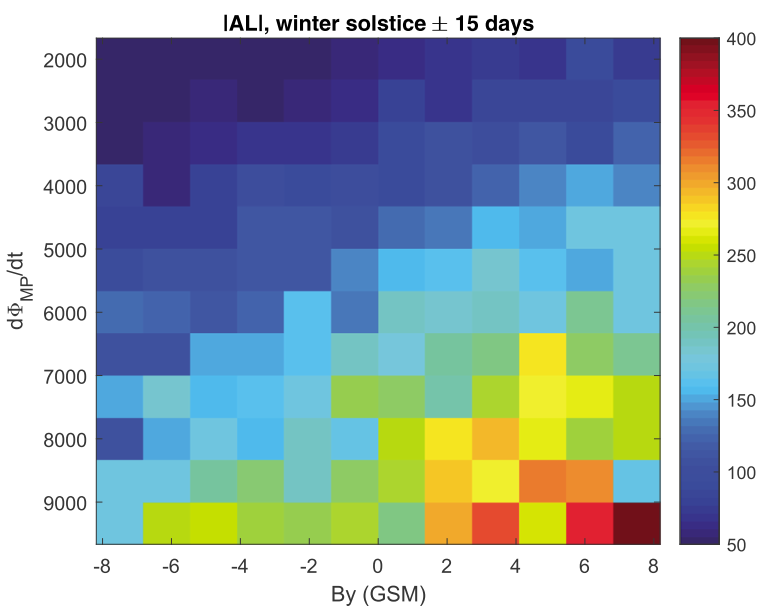
The interaction of the solar wind with the Earth's magnetic field produces geomagnetic activity, which is critically dependent on the orientation of the interplanetary magnetic field (IMF). It is well-known that geomagnetic activity strongly responds to the north-south (Bz) component of the IMF vector. However, recent studies have suggested that the dawn-dusk (By) component of IMF is an additional, independent driver of high‐latitude geomagnetic activity, leading to higher (weaker) geomagnetic activity in Northern Hemisphere (NH) winter for By >0 (By <0). In this paper we quantify the size of this explicit By effect with respect to the solar wind coupling function, both for northern and southern high‐latitude geomagnetic activity. We show that high‐latitude geomagnetic activity is significantly (by about 40%–50%) suppressed for By < 0 in NH winter and for By > 0 in Southern Hemisphere winter. When averaged over all months, high‐latitude geomagnetic activity in NH is about 12% weaker for By < 0 than for By > 0. The By effect affects the westward electrojet strongly, but hardly at all the eastward electrojet. We also show that the suppression of the westward electrojet in NH during By < 0 maximizes when the Earth's dipole axis points toward the night sector, that is, when the auroral region is maximally in darkness.
-
Reference:
- Rotation-Activity relation in global convection simulations
15 May 2018
-
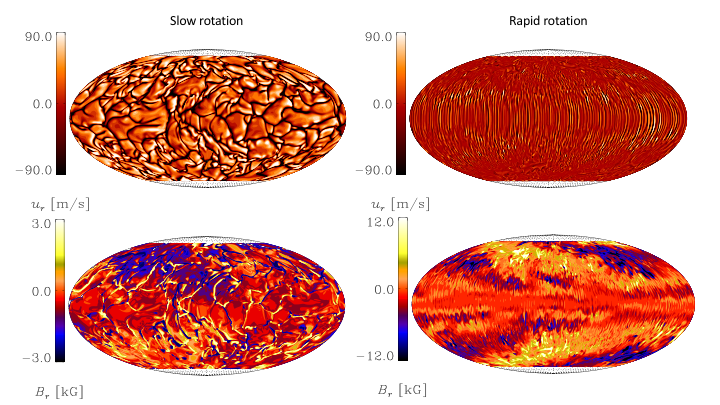
Stellar magnetic activity level and rotation are strongly connected. We studied the effect of increasing rotation rate on solar-like stars using magnetohydrodynamic simulations of stars with outer convective envelopes. At around 1.8 times the solar rotation rate, we found a transition point that separates slowly rotating, magnetically inactive stars, with rather axisymmetric large-scale magnetic fields (like our Sun), from more active, rapidly rotating, stars, with nonaxisymmetric large-scale magnetic fields. In the slow rotators we detected latitudinal dynamo waves reminiscent of the butterfly diagram of the Sun, while in the rapid rotators longitudinal dynamo waves were found. This essentially means that the nonaxisymmetric magnetic field modes rotate with a different speed than the stellar surface, that manifests itself as either prograde or retrograde migration of the magnetic structure. Such behaviour has also been observationally seen in active stars. Our results also highlight the importance of maintaining high enough supercriticality of convection, in particular, in the rapid rotation regime, where a too low supercriticality results in axisymmetric field configuration instead of a nonaxisymmetric one.
-
Reference:
- Effective energy of energy-integrating cosmic ray detector
22 November 2017
-
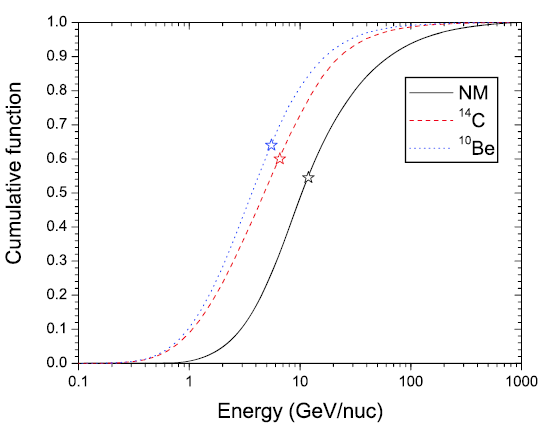
Fluxes of galactic cosmic rays (GCR) and their variability over different timescales are measured by ground-based instruments and methods, such as neutron monitors for the last 60 years or cosmogenic cosmogenic isotopes 10Be and 14C stored in natural archives on timescales of up to millennia. These detectors integrate energy of cosmic rays, and it is important to know their effective energy. In this work the effective yield functions for cosmogenic 14C (globally mixed in the atmosphere) and 10Be (realistically deposited in the polar region) are calculated and provided, in a tabulated form, in the supporting information. The effective energy of a detector is redefined with respect to simplified earlier studies, so that the variability of the flux of GCR particles at this energy is equal to that of the detector’s count rate. The effective energy is found as 11–12 GeV/nucleon for the standard polar neutron monitor, and 6–7 GeV/nucleon and 5.5–6 GeV/nucleon for 14C and 10Be, respectively, as shown in the Figure below. New “calibration” relations between the force-field modulation potentials, based on different models of local interstellar spectra (LIS) are provided. This work allows for harmonization of different works related to variability of galactic cosmic ray flux in the vicinity of Earth, on long-term scale.
-
Reference:
- Hidden solar magnetic cycle explained with modifications in turbulent induction and pumping
2 November 2017
-

The Sun, aside from its eleven year sunspot cycle is additionally subject to long term variation in its activity. We make use of a solar-like convective dynamo simulation of Käpylä et al. 2016, exhibiting equatorward propagation of the magnetic field, multiple frequencies, and irregular variability, including a missed cycle and complex parity transitions between dipolar and quadrupolar modes, to study the physical causes of such events. We use the test field analysis tool to measure and quantify the effects of turbulence in the generation and evolution of the large-scale magnetic field. The test-field analysis provides an explanation of the missing surface magnetic cycle in terms of the reduction of part of the alpha effect, the one of the key ingredients for dynamo action. Furthermore, we found an enhancement of downward turbulent pumping during the event to confine some of the magnetic field at the bottom of the convection zone, where local maximum of magnetic energy is observed during the event. At the same time, however, a quenching of the turbulent magnetic diffusivities is observed. For more detailed analysis, we will perform dedicated mean-field modelling with the measured turbulent transport coefficients in the future
-
Reference:
- No asymptotic regime found in high-resolution stellar dynamo simulations
2 June 2017
-
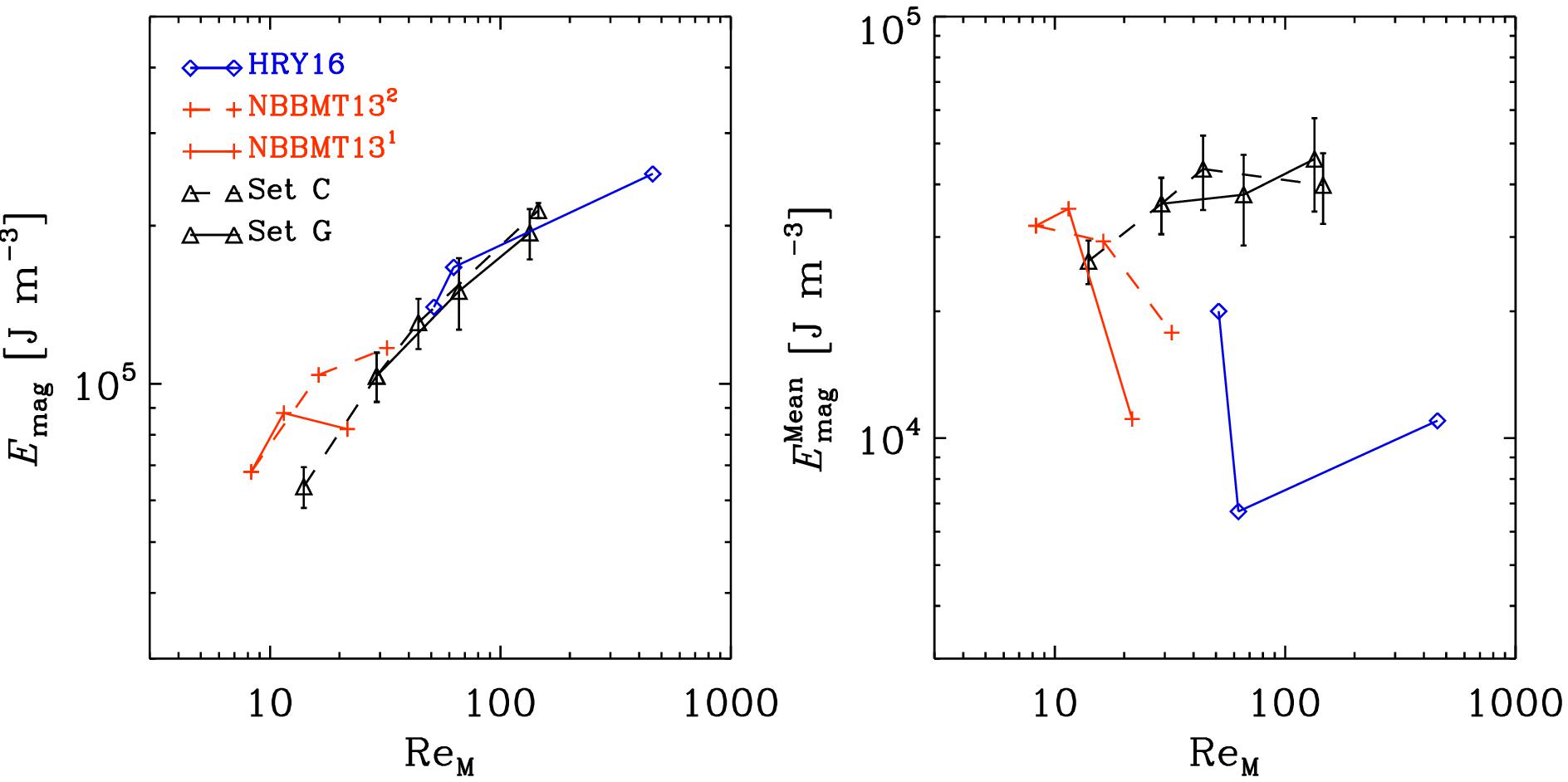
Three-dimensional magnetohydrodynamic simulations have recently been able to reproduce solar-like magnetic activity and non-axisymmetric large-scale magnetic fields self-consistently. The parameter regimes of such simulations are, however, still far removed from realistic conditions of stellar interiors. This study searches for an asymptotic regime where the large-scale features would no longer be dependent on the diffusion coefficients, and where the large-scale results would likely be representative of real stars. Instead, results depict that as the turbulence becomes more vigorous, differential rotation is severely quenched and no clear indication of an asymptotic regime is found even at the highest resolution. A vigorous small-scale dynamo is a possible culprit for the behavior and our results call for even higher resolution follow-up studies.
-
Reference:
- Magnetic flux concentrations from turbulent stratified convection
2 June 2017
-
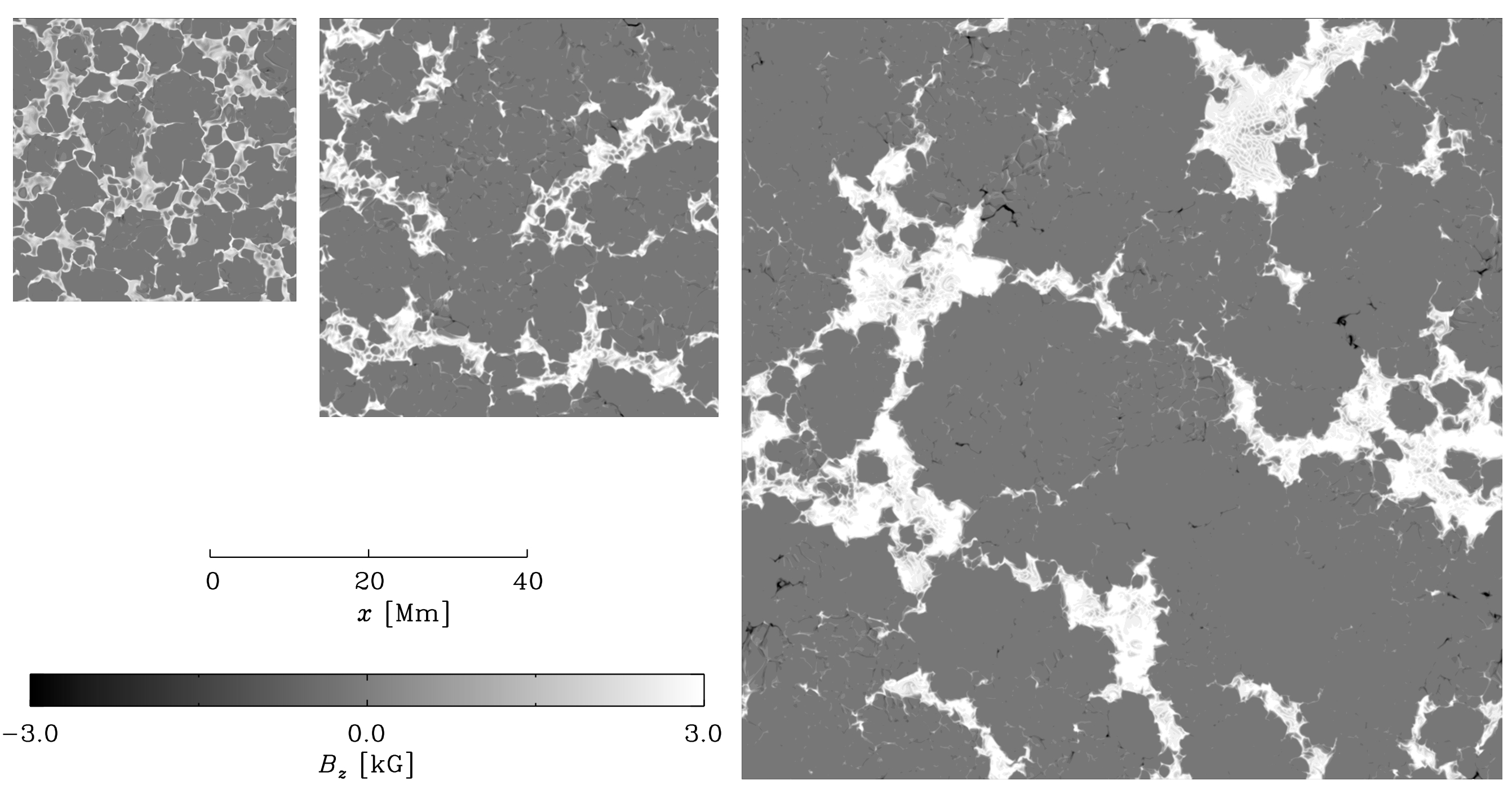
The formation of magnetic flux concentrations within the solar convection zone leading to sunspot formation remains poorly known. The self-organization of initially uniform sub-equipartition magnetic fields by highly stratified turbulent convection by performing magnetoconvection simulations in local domains has been studied. Results show that super-equipartition magnetic flux concentrations are formed spontaneously from the turbulent flow. The size of the concentrations increases as the box size increases and the largest structures (20 Mm horizontally near the surface) are obtained in the models that are 24 Mm deep. The field strength in the concentrations is in the range of 3-5 kG, almost independent of the magnitude of the imposed field. The linear growth of large-scale flux concentrations implies that their dominant formation process is a tangling of the large-scale field rather than an instability. One plausible mechanism that can explain both the linear growth and the concentration of the flux in the regions of converging flow pattern is flux expulsion.
-
Reference:
- The power of graphics processing units harnessed for high-accuracy turbulence modelling
2 June 2017
-
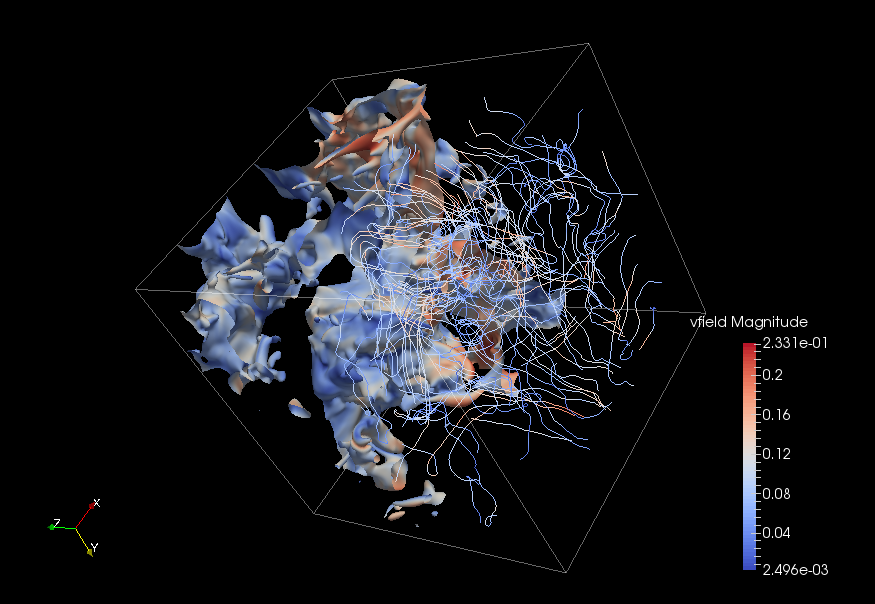
An effective method for accelerating fluid dynamics calculations with high-order precision on graphics processing units (GPUs) has been developed. This is done by efficient use of GPU memory with cache blocking and by dividing computation algorithms into memory efficient chunks. Nvidia CUDA based, proof of concept code Astaroth is able to achieve 3.6 times speedup in comparison to the reference code, which in practice allows for a week-long turbulence simulation to be performed within a couple of days.
-
Reference:
- Photospheric and coronal magnetic fields in six magnetographs
II. Harmonic scaling of field intensities 1 June 2017
-

Photospheric magnetic fields have been routinely observed since the 1970s by several ground-based and satellite instruments. While the different instruments show a fairly similar large-scale structure and temporal evolution of the photospheric magnetic field, the magnetic field intensity varies significantly between the observations. A new method for scaling the photospheric magnetic field in terms of the harmonic expansion can be straightforwardly used for data sets of different resolutions.
Different data sets generally scale to one another relatively well, with the exception of even axial terms, especially the axial quadrupole. Differences in polar field observations, pole filling, and data processing methods, as well as possible zero-level, mostly lead to a poor scaling between even axial terms. The pole-filling methods of KP and SOLIS data make the phase of the annual vantage point effect change opposite to the phase in MWO and WSO data. On the other hand, MDI pole filling appears to reduce the vantage point effect relatively successfully. The mutual scaling between SOLIS and HMI is very good, and one single overall coefficient of approximately 0.8 would be a reasonable choice for those data sets, at least up to m = 50. The slight increase of scaling factors with increasing n may relate to different spatial resolutions and related filling factors. Still, the relative errors remain rather small at least up to the studies' 180th harmonic, verifying that SOLIS and HMI synoptic maps depict similar magnetic field structures up to the resolution of 1 degree in latitude/longitude.
Scaling factors between harmonic coefficients depend on the order of the harmonic term since the relative contribution of the different harmonic terms to the field intensity at different latitudes varies in time. Results show that comparing harmonic terms between two data sets yields a simple and accurate scaling. We note that a correct scaling for the lowest harmonics is most essential for coronal modeling, since the lowest harmonics are the most important for coronal and heliospheric magnetic fields. -
Reference:
- The worst-case scenario of solar particle storm and its terrestrial influence is assessed
1 June 2017
-
Reference:
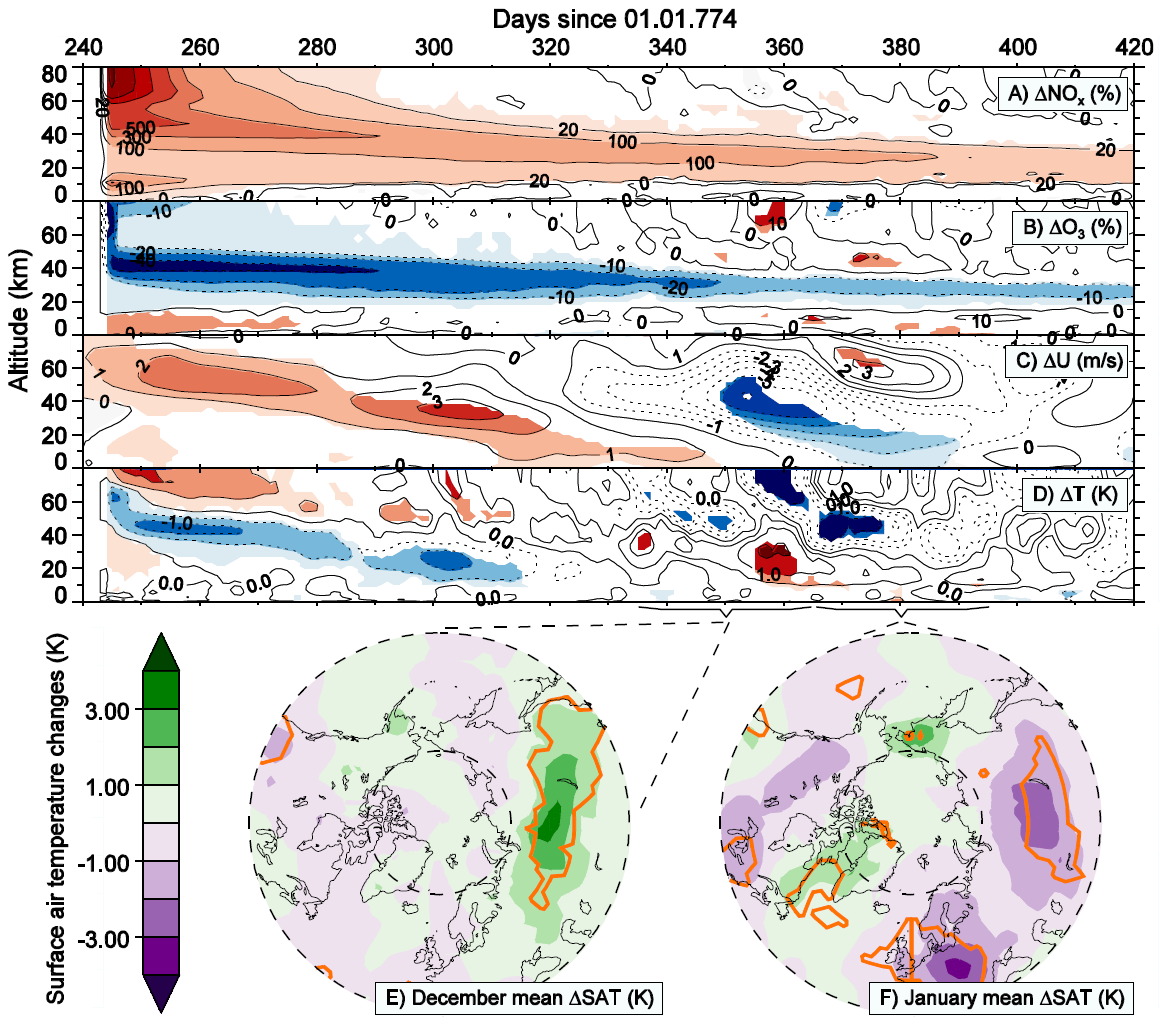
Sporadic solar energetic particle (SEP) events affect the Earth's atmosphere and environment, in particular leading to depletion of the protective ozone layer in the Earth's atmosphere, and pose potential technological and even life hazards for satellites and space/air-craft crew. The strongest observed solar particle storm occurred on 23-Feb-1956 and would harm or even kill astronauts if there were some on orbit. The greatest SEP storm known from indirect proxy for the last 11 millennia (the Holocene) occurred in 774-775 AD, serving as a likely worst-case scenario. It was 40-50 times stronger than any directly observed one. A systematic analysis of the impact such an extreme event can have on the Earth’s atmosphere has been presented recently by Sukhodolov et al. (2017). Using state-of-the-art cosmic ray cascade and chemistry-climate models, they successfully reproduced the observed variability of cosmogenic isotope 10Be, around 775 AD, in four ice cores from Greenland and Antarctica, thereby validating the models in the assessment of this event. It has been shown that no nitrate deposition signal can be detected in ice cores even for such an extreme solar storm and sub-annual data resolution, thus finally proving that nitrate cannot serve as a proxy for SEP events, contrary to some earlier claims. It is shown that such a severe event is able to perturb the polar stratosphere for at least one year, leading to regional changes in the surface temperature up to several degrees centigrade during northern hemisphere winters. ReSoLVE COSMIC team (E. Asvetsari and I. Usoskin) was responsible for computations of the cosmogenic isotope production and estimate of the SEP fluxes.
- Photospheric and coronal magnetic fields in six magnetographs
I. Consistent evolution of the bashful ballerina 17 Feb 2017
-
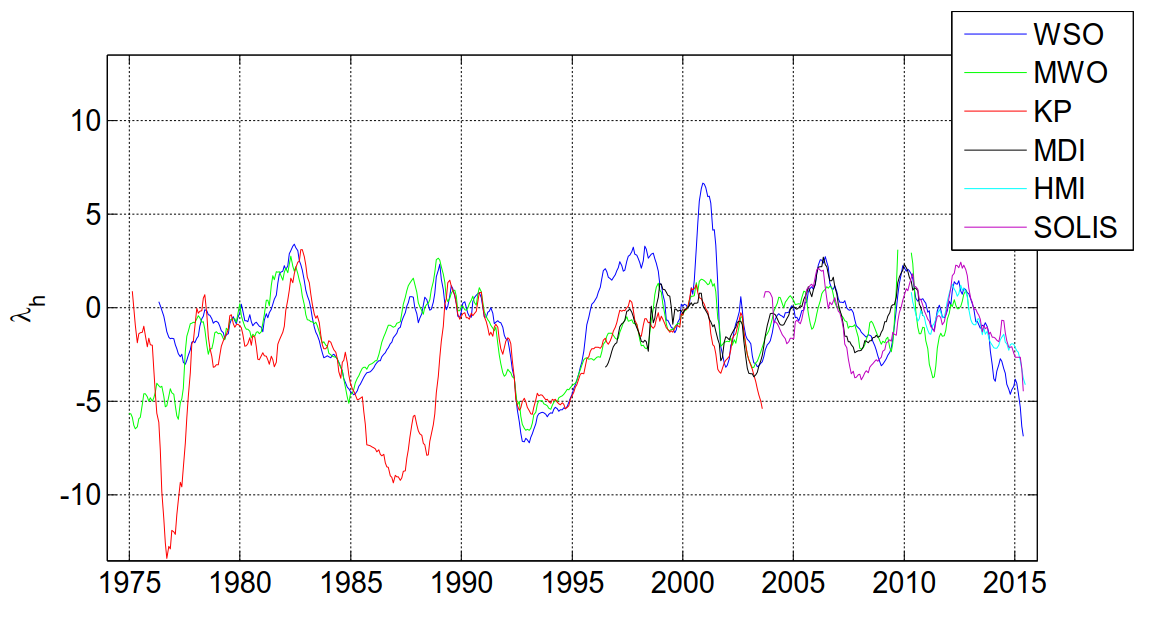
The hemispheric (north-south) asymmetry of solar and heliospheric magnetic fields has been studied and identified in several different parameters and by several different methods. These studies have led to the conclusion that the northern and southern solar hemispheres are connected, but not very tightly. The overall level of magnetic activity is not very different in the two hemispheres but, due to the different timing and distribution of activity, the asymmetry can be considerably large over most of the solar cycle. This study focus on the long-term evolution of photospheric and coronal magnetic fields and the heliospheric current sheet (HCS), especially its north-south asymmetry. Coronal magnetic field was constructed using synoptic maps of the photospheric magnetic field from Wilcox Solar Observatory (WSO), Mount Wilson Observatory (MWO), Kitt Peak (KP), SOLIS, SOHO/MDI and SDO/HMI, and the potential field source surface (PFSS) model. Special attention was paid to the reliability of the six data sets used, and to the consistency of the results based on them.
The six data sets depict a fairly similar long-term evolution of magnetic fields and agree on the southward shift of the heliospheric current sheet (the so called bashful ballerina phenomenon) in the declining to minimum phase of the solar cycle. We show that during solar cycles 20 -- 22, the the southward shift of the HCS is mainly due to the axial quadrupole term, reflecting the stronger magnetic field intensity at the southern pole during these times. During cycle 23 the asymmetry is less persistent and mainly due to higher harmonics than the quadrupole term. Currently, in the early declining phase of cycle 24, the HCS is also shifted southward and is mainly due to the axial quadrupole, as for most earlier cycles. This further emphasizes the special character of the global solar field during cycle 23. -
Reference:
- A new-generation model of production of cosmogenic isotopes in the Earth's atmosphere is created
18 Jan 2017
-
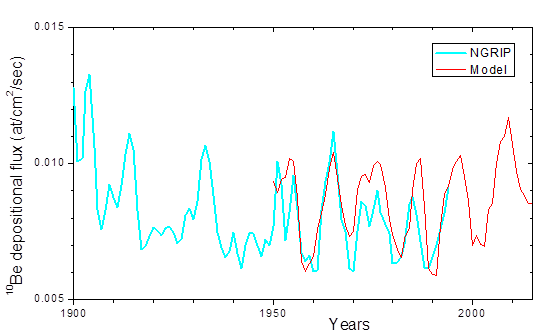
Cosmogenic isotopes, produced by cosmic rays in the Earth's atmosphere, and stored in natural dateable archives, form the only way to reconstruct solar variability in the past. For a reliable reconstruction, one needs a precise model of their production. Several such models exist but suffer from different kinds of uncertainties. A new consistent and precise computations of the production of five cosmogenic radioisotopes, 7Be, 10Be, 14C, 22Na, and 36Cl, in the Earth’s atmosphere by cosmic rays have been performed by the team and presented in the form of tabulated yield functions, superseding previous models. For the first time, a detailed set of the altitude profiles of the production functions is provided which makes it possible to apply the results directly as input for atmospheric transport models. The new model allows now to use cosmogenic isotope data directly (Figure A), without any ad-hoc normalization, which was impossible earlier. This opens a new prospective in the studies of long-term solar variability and it possible terrestrial effects.
-
Reference:
- The Maunder butterfly diagram extended by five cycles back, to the 1820s
18 Jan 2017
-
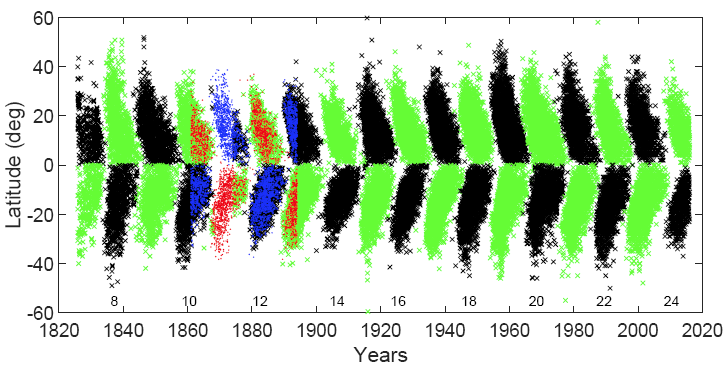
The spatio-temporal evolution of sunspot activity, the so-called Maunder butterfly diagram, is the most important feature to study the phenomenon of solar cyclic activity. It was continuously studied since 1874 using data from the Royal Greenwich Observatory, extended by SOON network data after 1976. Thanks to a collaboration with the Leibniz Institute for Astrophysics Potsdam (Germany), it has become possible to reconstruct a new extended butterfly diagram of sunspot group occurrence since 1826 (Figure A), using the recently digitized data from Schwabe (1826-1867) and Spörer (1866-1880). The presentation of the new data and their analysis has been published in two papers.
A new method has been developed to separate the wings of the diagram, leading to a study characteristic latitudes of each wing. A new, earlier unknown strong (5-6)-cycle periodic oscillation has been found in the start and end times of the wings and in the overlap and gaps between successive wings of one hemisphere. A marginally significant oscillation of about ten solar cycles was also found in the asymmetry of the end-cycle latitudes. The new long database of butterfly wings provides new observational constraints to solar dynamo models that discuss the spatio-temporal distribution of sunspot occurrence over the solar cycle and longer.
-
References:
Leussu, R., I. G. Usoskin, V. Senthamizh Pavai, A. Diercke, R. Arlt, C. Denker, K. Mursula, Wings of the butterfly: Sunspot groups for 1826-2015, Astron. Astrophys., 2017.
Leussu, R., I.G. Usoskin, R. Arlt, K. Mursula, Properties of sunspot cycles and hemispheric wings since the 19th century, Astron. Astrophys., 592, A160, 2016.
- Centennial evolution of the heliospheric magnetic field after the Maunder minimum is evaluated by an international scientific team
18 Jan 2017
-
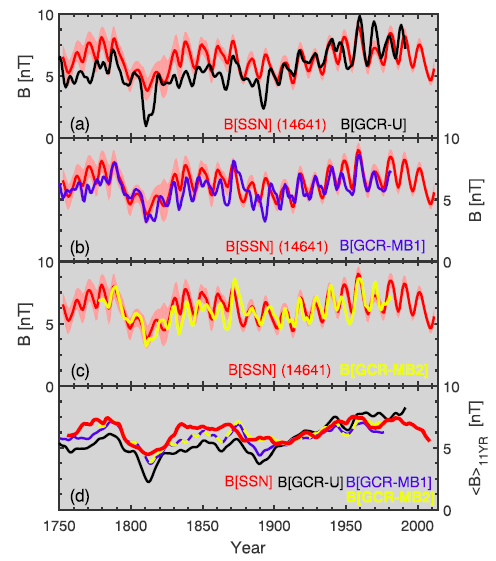
Solar magnetic field, dragged from the Sun by solar wind, fills the heliosphere and reflects different processes on the Sun. The intensity of the heliospheric magnetic field (HMF) is measured near Earth for the last decades by space-borne probes, but for many reasons it is important to know the centennial evolution of HMF, which can be studied only using indirect methods. Such methods include model computation of HMF (or open solar magnetic flux) from sunspot data, estimates based on the geomagnetic activity, and reconstructions from the cosmogenic isotope data. Different studies resulted in different estimates of HMF in the past, calling for a need for a consensus study- An international team of key scientists in all these fields had gathered for brainstorming at the International Space Science Institute (ISSI) at Bern to perform this task. As a result, two publications presenting a consensus view of the research community, have been produced, where all the reconstructions of HMF by different methods since 1750 were compared and uncertainties assessed. T he ReSoLVE was represented by the COSMIC team. An example of the agreement between different reconstructions i s shown in Figure A.
-
References:
Owens, M.J., E. Cliver, K. G. McCracken, J. Beer, L. Barnard, M. Lockwood, A. Rouillard, D. Passos, P. Riley, I. Usoskin, and Y-M. Wang, Near-Earth heliospheric magnetic field intensity since 1750: 1. Sunspot and geomagnetic reconstructions, J. Geophys. Res., 121, 6048–6063, 2016.
Owens, M.J., E. Cliver, K. G. McCracken, J. Beer, L. Barnard, M. Lockwood, A. Rouillard, D. Passos, P. Riley, I. Usoskin, and Y-M. Wang, Near-Earth heliospheric magnetic field intensity since 1750: 2. Cosmogenic radionuclide reconstructions, J. Geophys. Res.121, 6064–6074, 2016
- Sensitivity of the world neutron-monitor network for a solar neutron event is assessed
27 Jun 2016
-
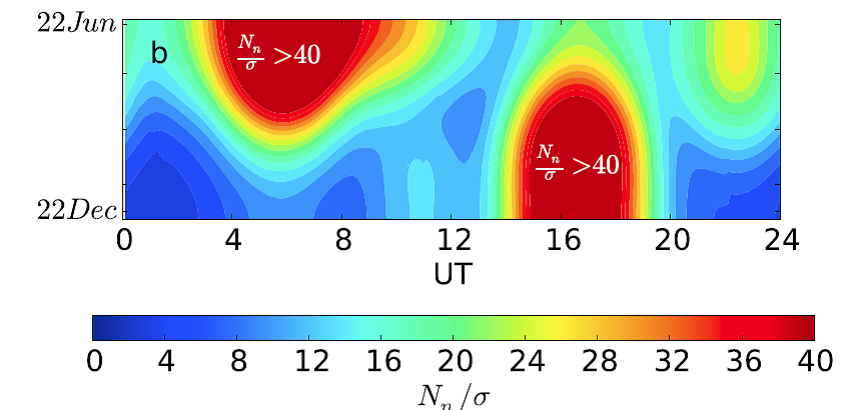
Free neutron are unstable with the life-time of about 10 minutes. Therefore, there is no extra-terrestrial neutrons in our environment, except of one particular case, related to strong solar flares. Sometimes protons, accelerated during a flare in a close magnetic loop in the solar atmosphere, can precipitate to the dense solar surface producing there energetic neutrons. Since neutrons are neutral, they are not trapped by the solar magnetic fields and easily escape from the Sun. Such solar neutrons can be occasionally detected at Earth, since their time of fight is comparable with the life time. It is important to detect such events since solar neutrons carry direct information of the dense layers of the solar atmosphere and surface.
How well are we prepared to detect such events? The COSMIC team investigated this and assessed the sensitivity of the existing global network of ground-based neutron monitors (NMs), as shown in Figure A. The assessment was based on the new yield function of a standard neutron monitor 6NM64 for solar neutrons computed for a wide range of altitudes of the neutron monitor locations and angles of incidence for neutrons entering the Earth’s atmosphere. The computations were made by Monte Carlo using the GEANT4-based PLANETOCOSMICS tool. The computations were validated against the measured data for the greatest solar neutron events of 3 June 1982 and 24 May 1990, and good agreement was found.
The neutron monitor network is shown to be a sensitive tool for monitoring of high-energy solar-flare neutrons with about 95% probability to detect statistically significantly a solar neutron event similar to that of 3 June 1982.
-
Reference:
- A new Monte-Carlo model of atmospheric ionization by precipitating electrons is developed
27 Jun 2016
-
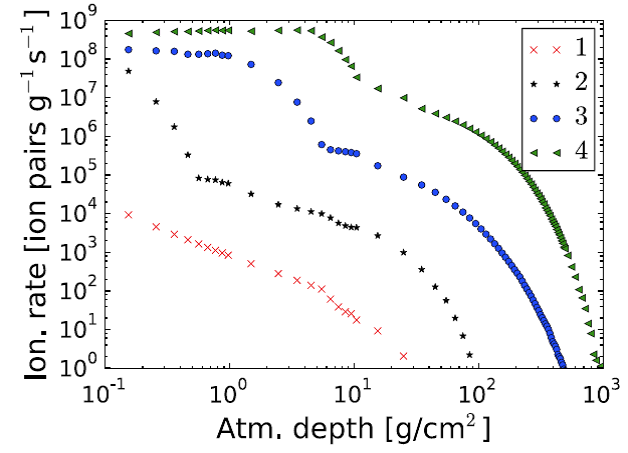
A new model of the family of CRAC models, CRAC:EPII (Cosmic Ray Atmospheric Cascade: Electron Precipitation Induced Ionization), has been developed by the COSMIC team in the framework of the ReSoLVE task. The model calculates atmospheric ionization induced by precipitating electrons, specifically in polar regions and in middle-upper atmosphere, and uses the formalism of ionization yield functions. The CRAC:EPII model is based on a full Monte Carlo simulation of electron propagation and interaction with the air molecules. It explicitly considers various physical processes, namely, pair production, Compton scattering, generation of bremsstrahlung high-energy photons, photoionization, annihilation of positrons, and multiple scattering. It is shown that electromagnetic radiation from bremsstrahlung of electrons stopped in the upper atmosphere may contribute significantly to the ionization of the middle atmosphere, which is often neglected in simplified models, leading to incorrect results. This feature is fully taken into consideration in the new research.
The CRAC:EPII model is applicable to the entire atmosphere. The results from the simulations are given as look-up table representing the ionization yield function. The table allows one to compute ionization due to precipitating electrons for a given altitude and location considering a given electron spectrum. Application of the model for computation of ion production during electron precipitation events using spectra from balloon-borne measurements is shown in the Figure A. Contribution form electron bremsstrahlung is visible as extended tails at larger atmospheric depths beyond 1-10 g/cm2.
-
Reference:
- High-speed solar wind streams are the dominant driver of energetic particle precipitation
13 Apr 2016
-
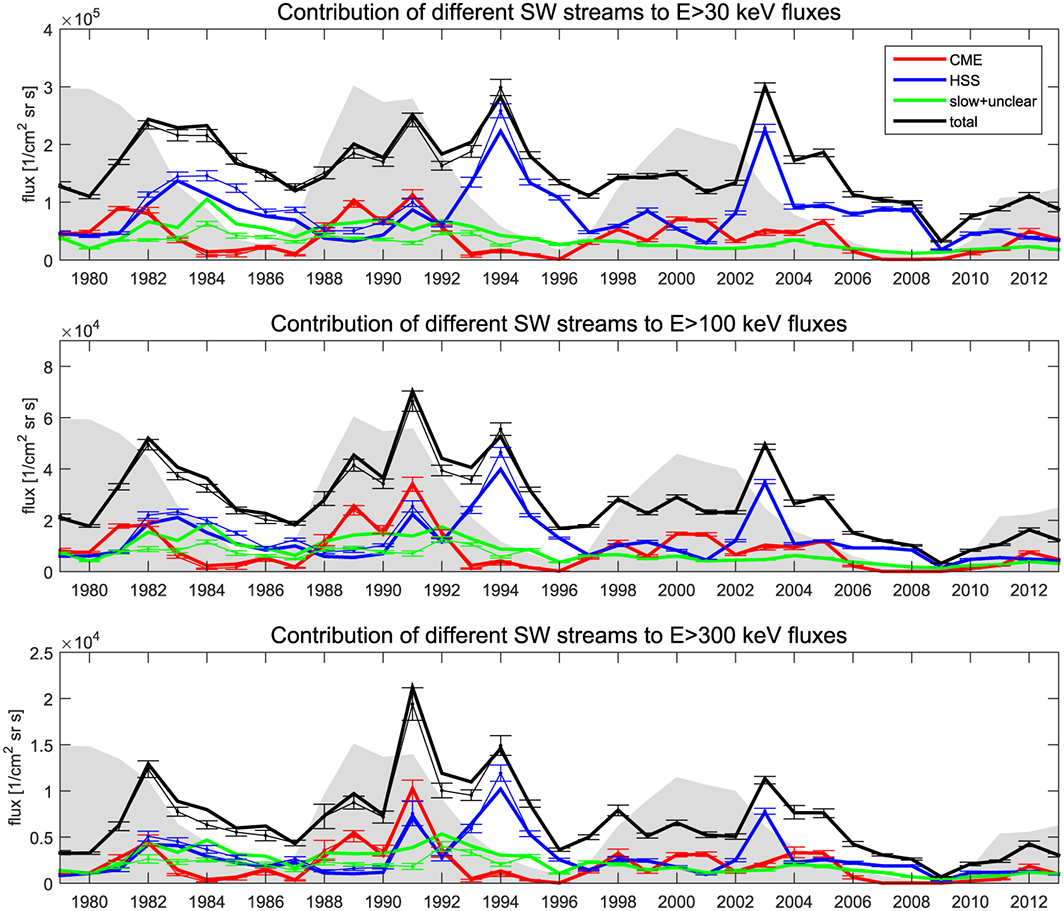
Disturbances of near-Earth space are predominantly driven by coronal mass ejections (CMEs) mostly originating from sunspots and high-speed solar wind streams (HSSs) emanating from coronal holes. The relative importance of CMEs and HSSs as well as slow solar wind in producing energetic electron precipitation was studied in detail in a recent paper by Asikainen and Ruopsa (2016) by utilizing the corrected energetic electron measurements from the MEPED instrument on board low-altitude NOAA/POES satellites from 1979 to 2013. Using solar wind observations categorized into three different flow types, it was possible to separate the contributions of these flows to annual electron precipitation and to quantify their efficiencies in producing precipitation. The study found that HSS contribution nearly always dominates over the other flows and peaks strongly in the declining solar cycle phase. CME contribution mostly follows the sunspot cycle but is typically enhanced also in the declining phase. Rather surprisingly the study found that the efficiency of both HSSs and also CMEs peaks in the declining phase. Detailed quantification of how the electron precipitation depends on solar wind southward magnetic field component, speed, and density revealed that the solar wind speed is the dominant factor affecting the precipitation in all solar wind flow types. It is well known that drag forces affecting the propagation of CMEs in in the interplanetary space act to either accelerate or decelerate CMEs towards background solar wind speed. Since HSSs enhance the average solar wind speed in the declining solar cycle phase, they also accelerate CMEs to higher speeds and thus enhance the efficiency of CMEs during these times. It thus seems that high-speed solar wind streams have thus have a double effect in enhancing energetic electron precipitation by also affecting the precipitation efficiency of CMEs embedded in high-speed streams.
-
Reference:
- Sunspot numbers are recalibrated and confirm the Modern grand maximum
13 Apr 2016
-
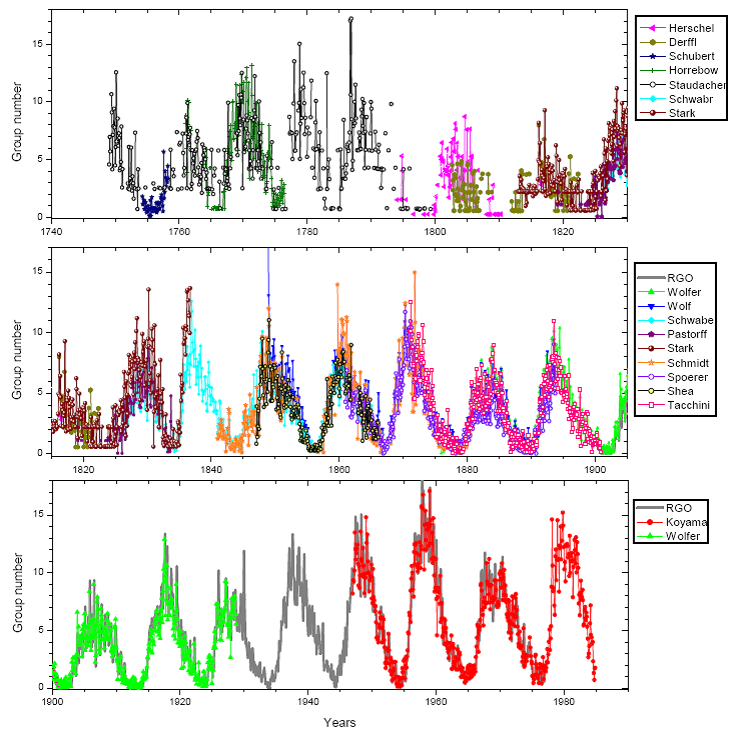
Sunspot numbers provide a uniquely long index of solar activity spanning over 400 years. However they are still the subject of intense debate, with the largest uncertainty being related to the “calibration” of the visual acuity of individual observers in the past. A novel method for calibrating the visual acuity of the key solar observers in the 18th and 19th centuries to the reference data set of Royal Greenwich Observatory sunspot groups for the period 1900 – 1976, using the statistics of the active-day fraction, is presented. Observational thresholds [Ss] were defined for each observer such that the observer is assumed to miss all of the groups with an area smaller than Ss and report all the groups larger than Ss. Next, correction matrices were constructed for each observer regarding the reference data set using the Monte-Carlo method, that were applied to the original sunspot group records reported by the observers for each day (see Figure A), and finally the composite corrected series is produced for the period since 1748. The new group sunspot number series has been presented which is close to the 'classical' group sunspot number by Hoyt and Schatten (1998) but essentially lower than a recent reconstruction by Svalgaard and Schatten (2016), suggesting that the latter overestimates sunspot activity because of the used linear regression method. This result confirms the uniqueness of the grand maximum is confirmed for the last 250 years. This result is confirmed by a direct comparison with cosmogenic isotopes data of 14C in tree rings and 44Ti in fallen meteorites.
-
Reference:
Usoskin, I.G., G.A. Kovaltsov, M. Lockwood, K. Mursula, M. Owens, S.K. Solanki, A New Calibrated Sunspot Group Series Since 1749: Statistics of Active Day Fractions, Solar Physics, 291, 2685-2708, 2016.
Usoskin, I.G., U G.A. Kovaltsov, T. Chatzistergos, Dependence of the Sunspot-Group Size on the Level of Solar Activity and its Influence on the Calibration of Solar Observers, Solar Physics, 291, 3793-3805, 2016
- Nitrate may serve as a new chemical proxy for long-term cosmic-ray and solar variability
13 Apr 2016
-
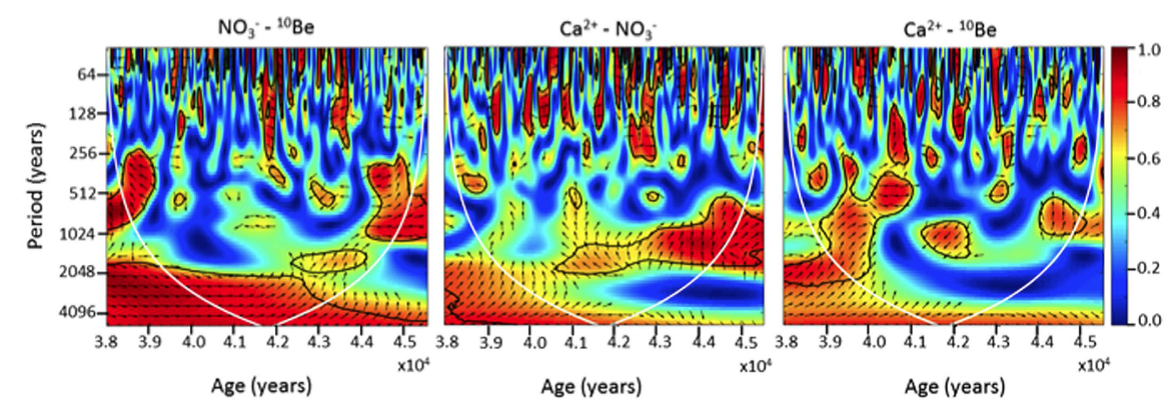
The first direct comparison of cosmogenic 10Be record and chemical species measured in the Antarctic EPICA-Dome C ice core for the period of 38–45.5 kyr BP spanning the Laschamp geomagnetic excursion, when the geomagnetic field almost vanished, is presented. The methods of principal component analysis (PCA) and wavelet coherence (WC) were applied to group different components as a function of the main sources, transport and deposition processes affecting the atmospheric aerosol at Dome C over that period. The evident preferential association of 10Be with nitrate rather than with other chemical species was found implying for the presence of a distinct cosmogenic source of these markers. The role of calcium in driving the 10Be and nitrate relationship was shown to be insignificant, implying that the signal is mostly driven by production rather than by transport in the atmosphere. This is particularly relevant for a plateau site such as Dome C, especially in the glacial period during which the Laschamp excursion took place. The evidence that the nitrate record from the EDC ice core is able to capture the Laschamp event hints toward the possibility of using this marker for studying galactic cosmic ray flux variations and thus also major geomagnetic field excursions at pluri-centennial-millennial time scales, thus opening up new perspectives in paleoclimatic studies.
-
Reference:
- The enigmatic Hallstatt cycle (~2400 years) is of solar origin
13 Apr 2016
-
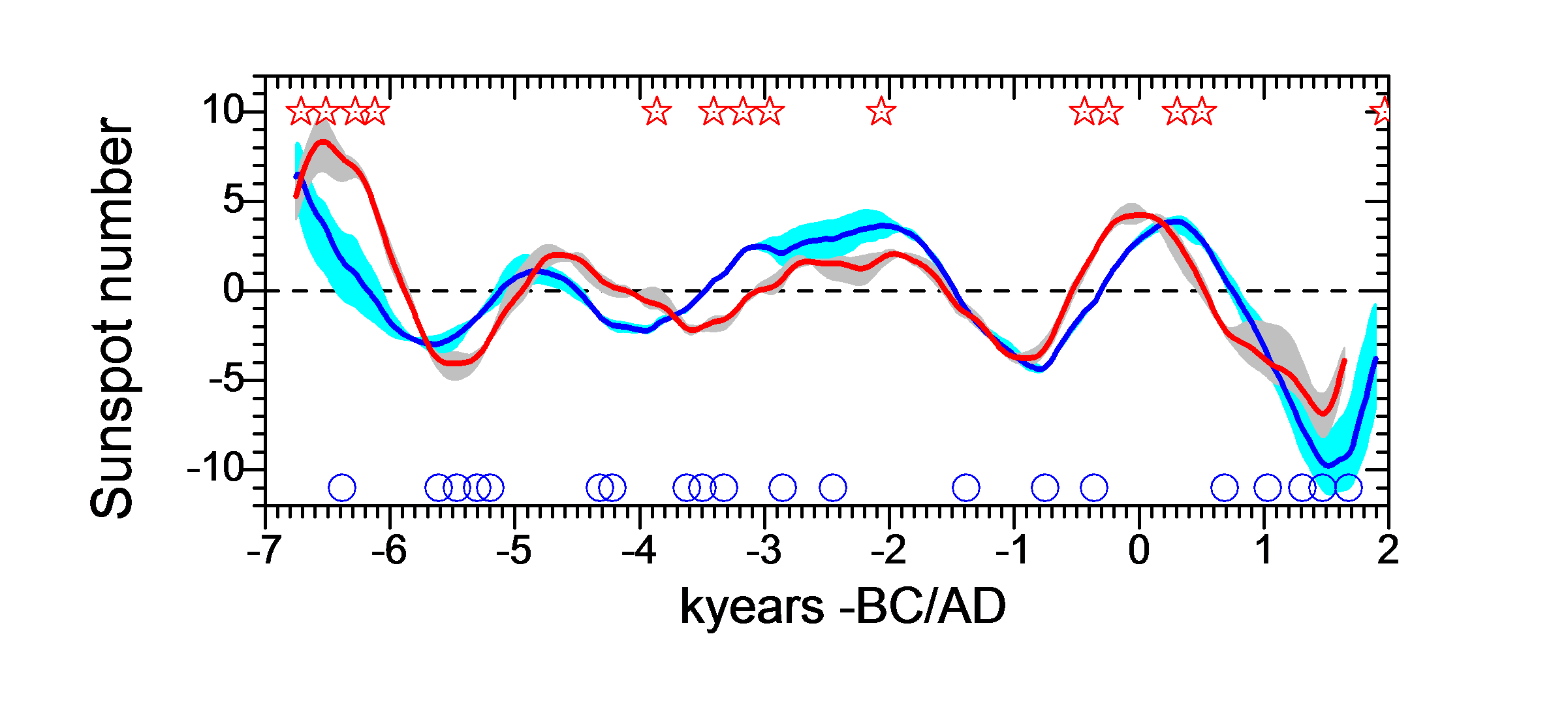
The only quantitative proxy to study the long-term solar variability over a centennial-millennial timescale is related to cosmogenic isotope proxies. While essential progress has been achieved in both measurements and modelling of the cosmogenic proxy, uncertainties still remain in the determination of the geomagnetic dipole moment evolution. A new improved reconstruction of solar activity over the past nine millennia has been presented, based on cosmogenic records of 14C in tree rings and 10Be in polar ice cores, using a multi-proxy approach using the most up-to-date models of cosmogenic isotope production and transport in Earth’s atmosphere, and available geomagnetic field reconstructions, including a new reconstruction relying on an updated archeo- and paleointensity database. The reconstruction was analyzed using the singular spectrum analysis (SSA) method to study the millennial-scale trends. The primary components of the reconstructed solar activity, as determined using the SSA method, were found different for the series that are based on 14C and 10Be. This shows that these primary components can only be ascribed to long-term changes in the terrestrial system and not to the Sun. These components have therefore been removed from the reconstructed series. In contrast, the secondary SSA components of the reconstructed solar activity are found to be dominated by a common ≈2400-year quasi-periodicity, the so-called Hallstatt cycle, in both the 14C and 10Be based series. This Hallstatt cycle thus appears to be related to solar activity. It is shown that the grand minima and maxima of solar activity occurred intermittently over the studied period, with clustering near lows and highs of the Hallstatt cycle, respectively.
-
Reference:
- Solar magnetic fields reconstructed from historical observations
12 Nov 2015
-
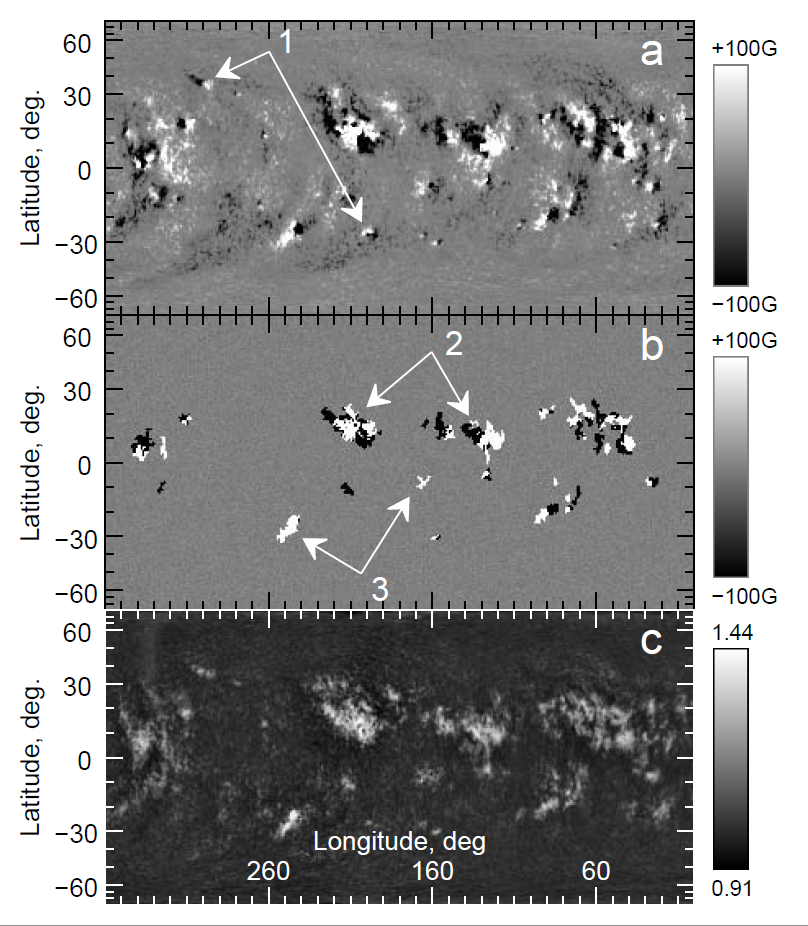
Direct measurements of the solar magnetic field started in 1917 with measurements of sunspot field strength at Mount Wilson Observatory. The first magnetographic observations date back to late 1950s, with routine synoptic observations of full disk magnetograms starting in early 1970s. The full disk magnetograms provide the most complete information about polar fields, although limited information can be inferred from surface distribution of certain photospheric and chromospheric structures (e.g., polar crown filaments may outline the location of lower boundary of polar unipolar field). Correlation between bright chromospheric plages observed in Ca II K 393.37 nm spectral line and unsigned magnetic flux was noted from the very beginning of magnetographic observations in 1950s. Accordingly, the brightness of the chromospheric Ca II K spectral line available in the form of full disk images (spectroheliograms) of the Sun can be used as a proxy for solar magnetic fields.
A recent article by Pevtsov et al. is the first in a series of articles attempting to develop a new proxy for the evolution of magnetic activity in past solar cycles by combining the information from historical Ca II K line spectroheliograms and sunspot magnetic field measurements. The proxy is based on the relationship between magnetic flux and CaK line intensity (contrast) obtained from using Ca K line and sunspot magnetic field observations at Mount Wilson Observatory (MWC) and magnetograms of the National Solar Observatory at Kitt Peak. They used synoptic (Carrington) maps in 1915–1985 derived from daily Ca K line observations at Mount Wilson Observatory to identify the chromospheric plages, and to create synoptic pseudo-magnetograms. The study shows that using a combination of sunspot field measurements and the plages with renormalized intensities one can successfully construct a homogeneous long-term series of pseudo-magnetograms which highly correlate with the observed magnetic field data (correlation 0.98).
-
Reference:
- Reassessment of multiple datasets proves that the Maunder minimum (1645-1715) was indeed a grand minimum of solar activity
11 Nov 2015
-
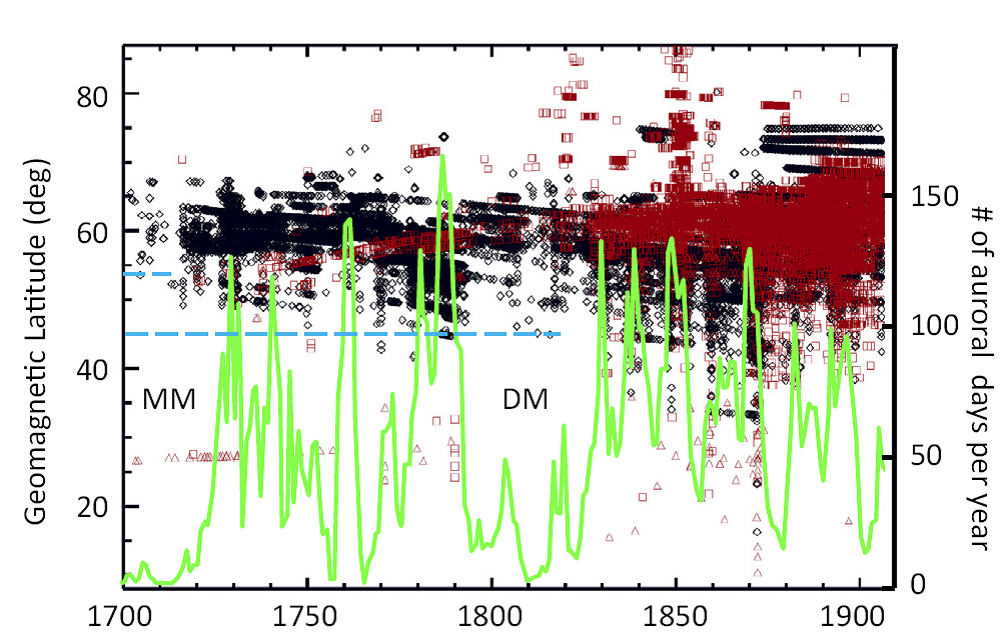
The Maunder minimum (MM) in 1645-1715 was a period when there were almost no sunspots on the Sun. This forms a paradigm for the general concept of a Grand minimum of solar activity which is important for solar/stellar dynamo theory and solar-terrestrial relations. Although the Maunder minimum was covered by the benchmark sunspot number series, uncertainties still remain on the exact level of solar activity in the 17th century. In particular, several claims were made, suggesting that it may be moderate because of the 17th century astronomers might had been affected by the dogma on the "perfectness of the Sun" which should have 'imperfect' spots.
A reassessment of the level of solar activity during the MM was made, using all the existing, both direct and indirect, datasets and evidence has found to show that the activity was very low, significantly lower than during any other period over the last centuries including the current weak solar cycle #24. As an example, the incut Figure shows occurrence of auroral reports for 1700-1900. The green line is the number of auroral nights at geomagnetic latitudes below 56° from a combination of several catalogues. The points show the geomagnetic latitude and time of auroral sightings from the catalogue of Vázquez et al. (2014). Once can see that during the MM, auroral reports were not only significantly less frequent, but they were also high-latitude, limited to the (sub)auroral zone, indicating the absence of moderate-strong geomagnetic storms.
The careful revision of all the presently available datasets for the Maunder minimum proves that solar activity was indeed at an exceptionally low level during that period, corresponding to a special grand minimum mode of solar dynamo.
-
Reference:
- Short-living cosmogenic isotope 7Be is shown to be a proxy for large scale atmospheric dynamics
11 Nov 2015
-
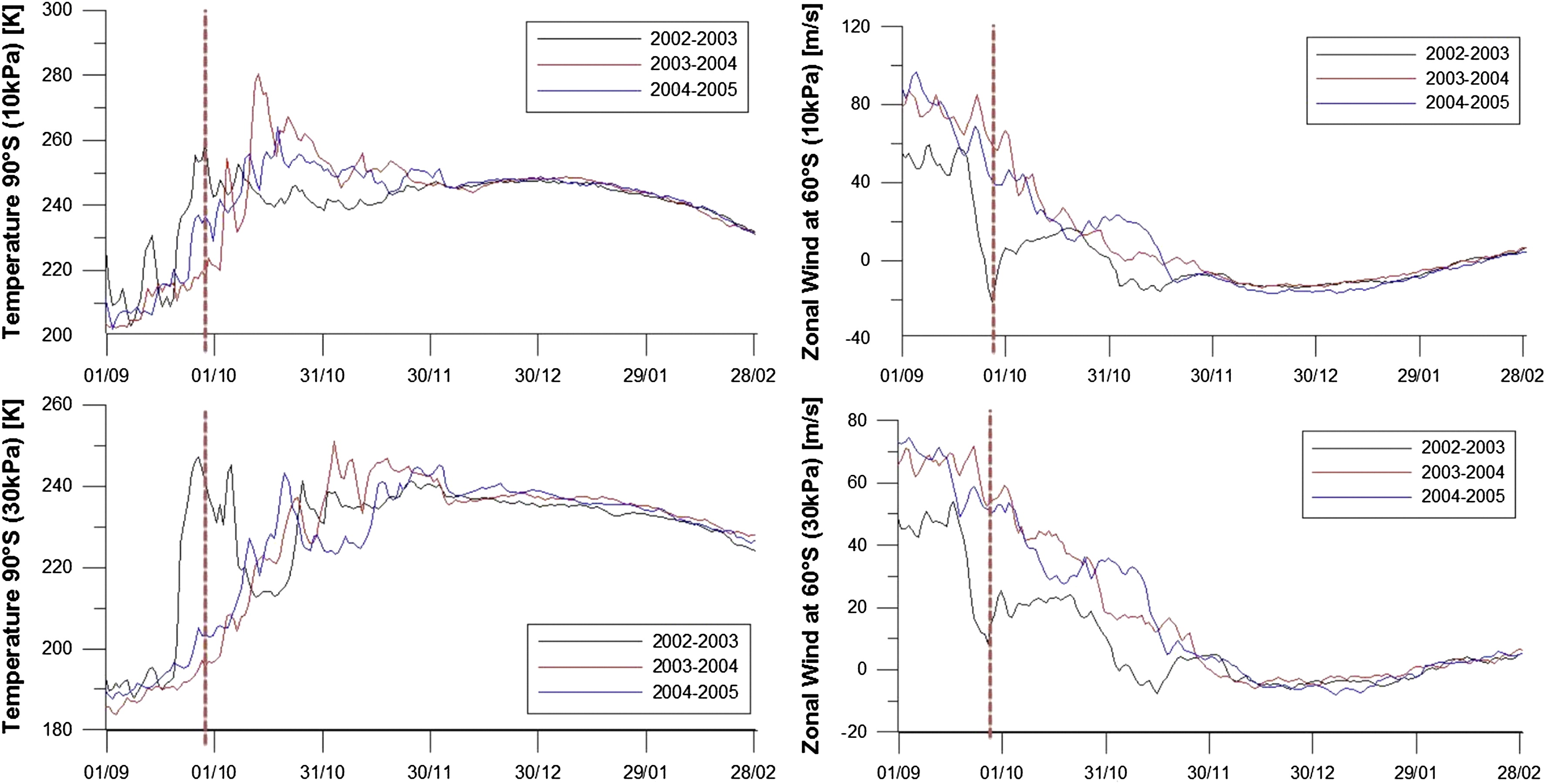
Recent study finds that cosmogenic 7Be isotopes produced in the lower stratosphere were measured in near-ground air at Rio de Janeiro, Brazil, after the southern hemispheric Sudden Stratospheric Warming (SSW) of 2002. The study was based on a comparison of 7Be data measured around Angra Nuclear Power Station (23 S 44 W) during the last three decades and a model estimate of the near-ground air 7Be concentration using the CRAC:7Be model of cosmogenic production together with a simplified model for atmospheric 7Be deposition that assimilates the regional precipitation data. The results of the study indicate that an anomalous stratosphere-troposphere coupling associated to the unique SSW of 2002 allowed stratospheric aerosols carrying 7Be to reach the ground level very quickly. This methodology points to an important use of 7Be as a quantitative tracer for stratospheric influence on near-ground air patterns.
-
Reference:
- Declining solar cycle phase favors positive NAO
14 Aug 2015
-
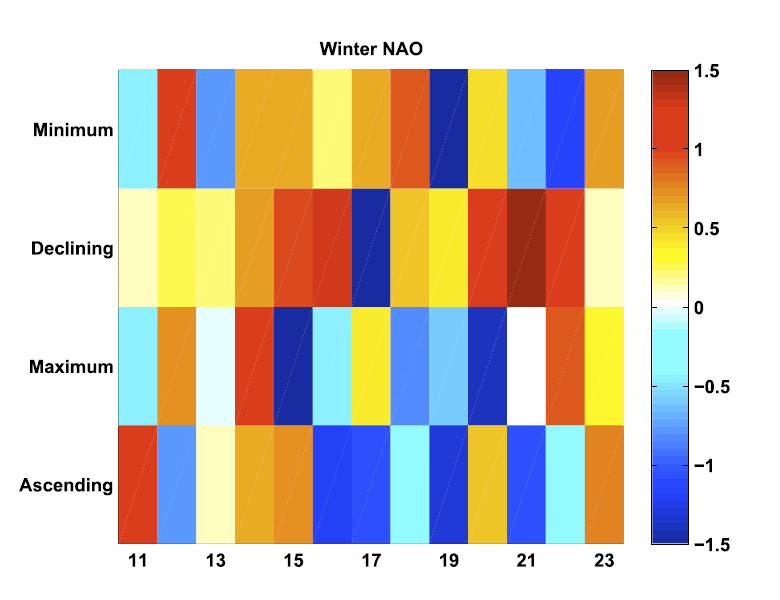
Several recent studies have found variability in the Northern Hemisphere winter climate related to different parameters of solar activity. While these results consistently indicate some kind of solar modulation of tropospheric and stratospheric circulation and surface temperature, opinions on the exact mechanism and the solar driver differ. Proposed drivers include, e.g., total solar irradiance (TSI), solar UV radiation, galactic cosmic rays, and magnetospheric energetic particles. While some of these drivers are difficult to distinguish because of their closely similar variation over the solar cycle, other suggested drivers have clear differences in their solar cycle evolution. For example, geomagnetic activity and magnetospheric particle fluxes peak in the declining phase of the sunspot cycle, in difference to TSI and UV radiation which more closely follow sunspots. Using 13 solar cycles (1869-2009), we study winter surface temperatures and North Atlantic oscillation (NAO) during four different phases of the sunspot cycle: minimum, ascending, maximum, and declining phase. We find significant differences in the temperature patterns between the four cycle phases, which indicates a solar cycle modulation of winter surface temperatures. However, the clearest pattern of the temperature anomalies is not found during sunspot maximum or minimum, but during the declining phase, when the temperature pattern closely resembles the pattern found during positive NAO. Moreover, we find the same pattern during the low sunspot activity cycles of 100 years ago, suggesting that the pattern is largely independent of the overall level of solar activity.
-
Reference:
- New reconstruction of solar wind speed gives support to solar dynamo theory
13 Aug 2015
-
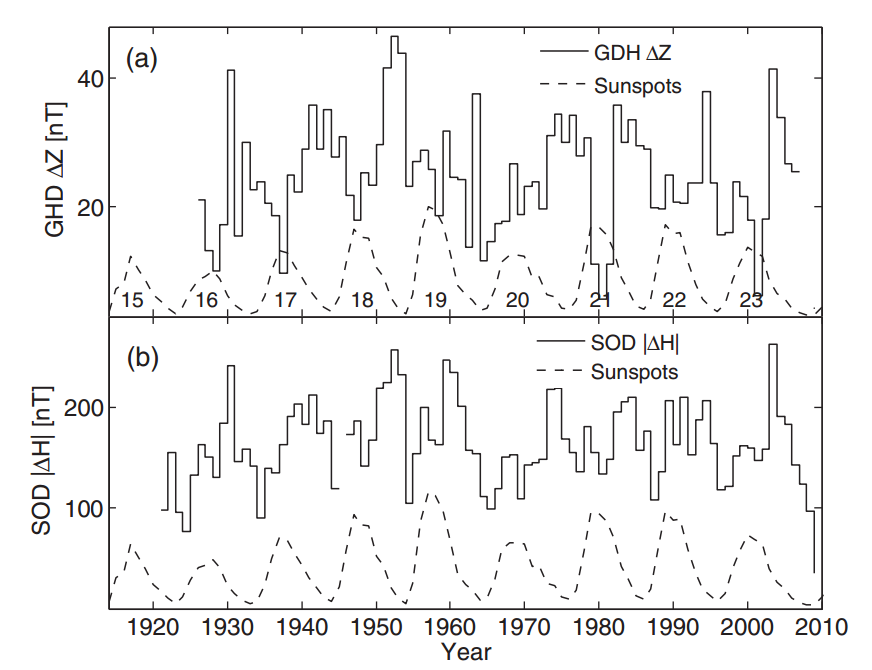
In the declining phase of the solar cycle (SC), when the new-polarity fields of the solar poles are strengthened by the transport of same-signed magnetic flux from lower latitudes, the polar coronal holes expand and form non-axisymmetric extensions toward the solar equator. These extensions enhance the occurrence of high-speed solar wind (SW) streams (HSS) and related co-rotating interaction regions in the low-latitude heliosphere, and cause moderate, recurrent geomagnetic activity (GA) in the near-Earth space. Here, using a novel definition of GA at high (polar cap) latitudes and the longest record of magnetic observations at a polar cap station, we calculate the annually averaged SW speeds as proxies for the effective annual occurrence of HSS over the whole Grand Modern Maximum (GMM) from 1920s onward.
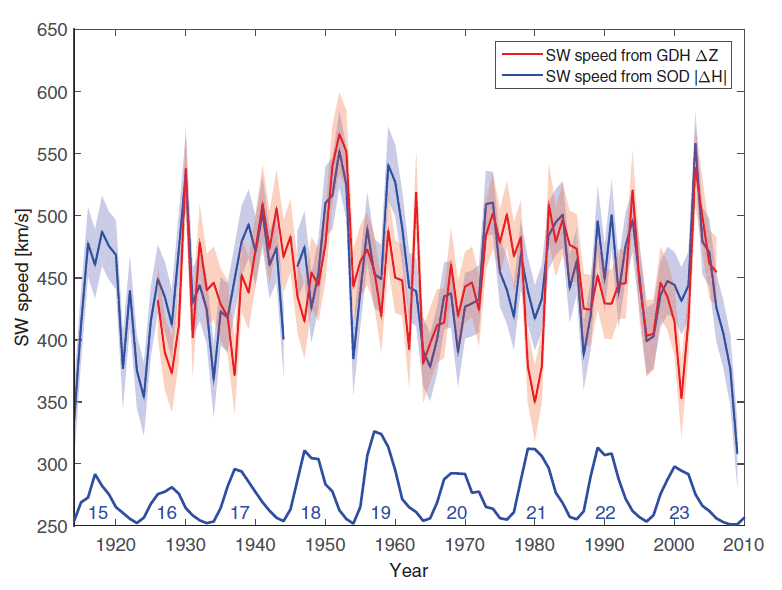
We find that a period of high annual speeds (frequent occurrence of HSS) occurs in the declining phase of each of SCs 16-23. For most cycles the HSS activity clearly reaches a maximum in one year, suggesting that typically only one strong activation leading to a coronal hole extension is responsible for the HSS maximum. We find that the most persistent HSS activity occurred in the declining phase of SC 18. This suggests that cycle 19, which marks the sunspot maximum period of the GMM, was preceded by exceptionally strong polar fields during the previous sunspot minimum. This gives interesting support for the validity of solar dynamo theory during this dramatic period of solar magnetism.
-
Reference:

